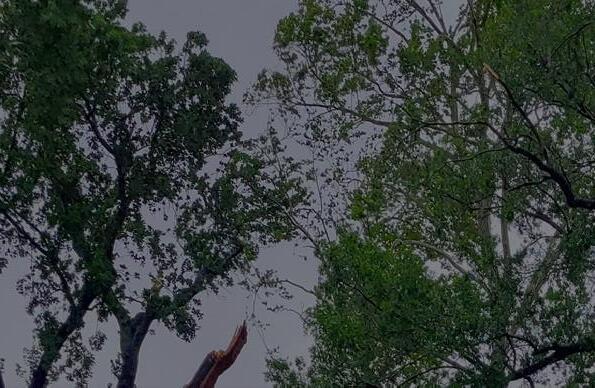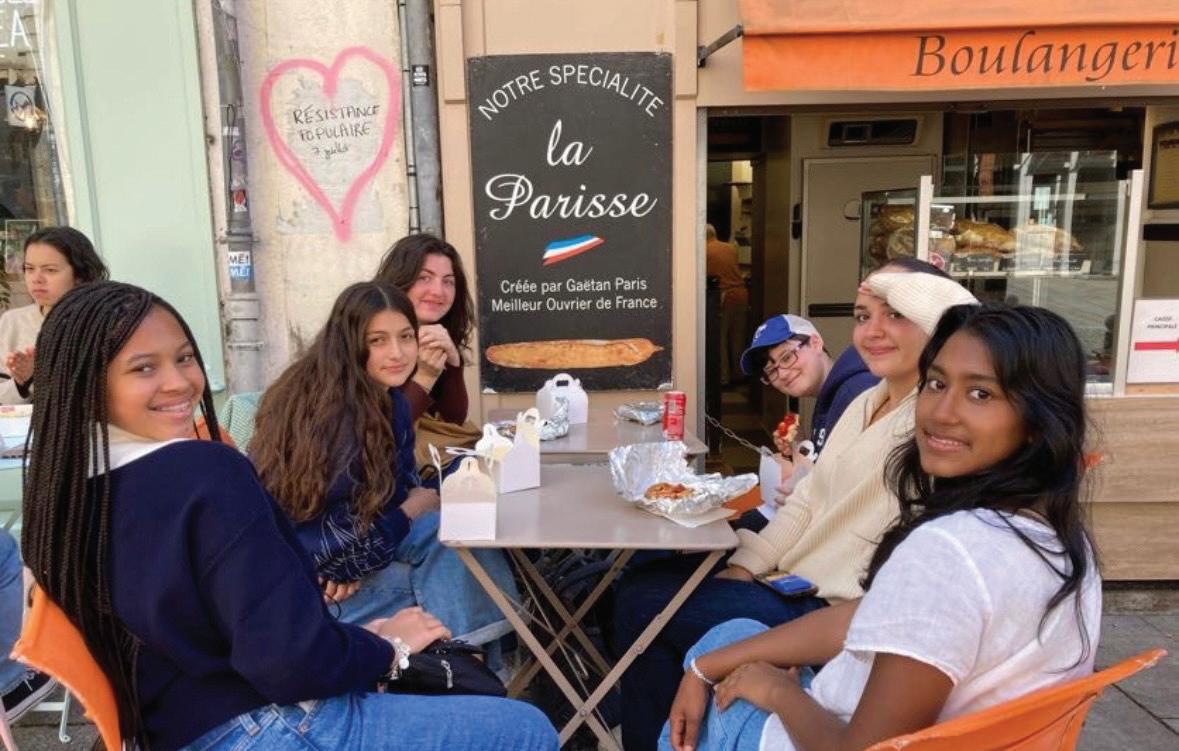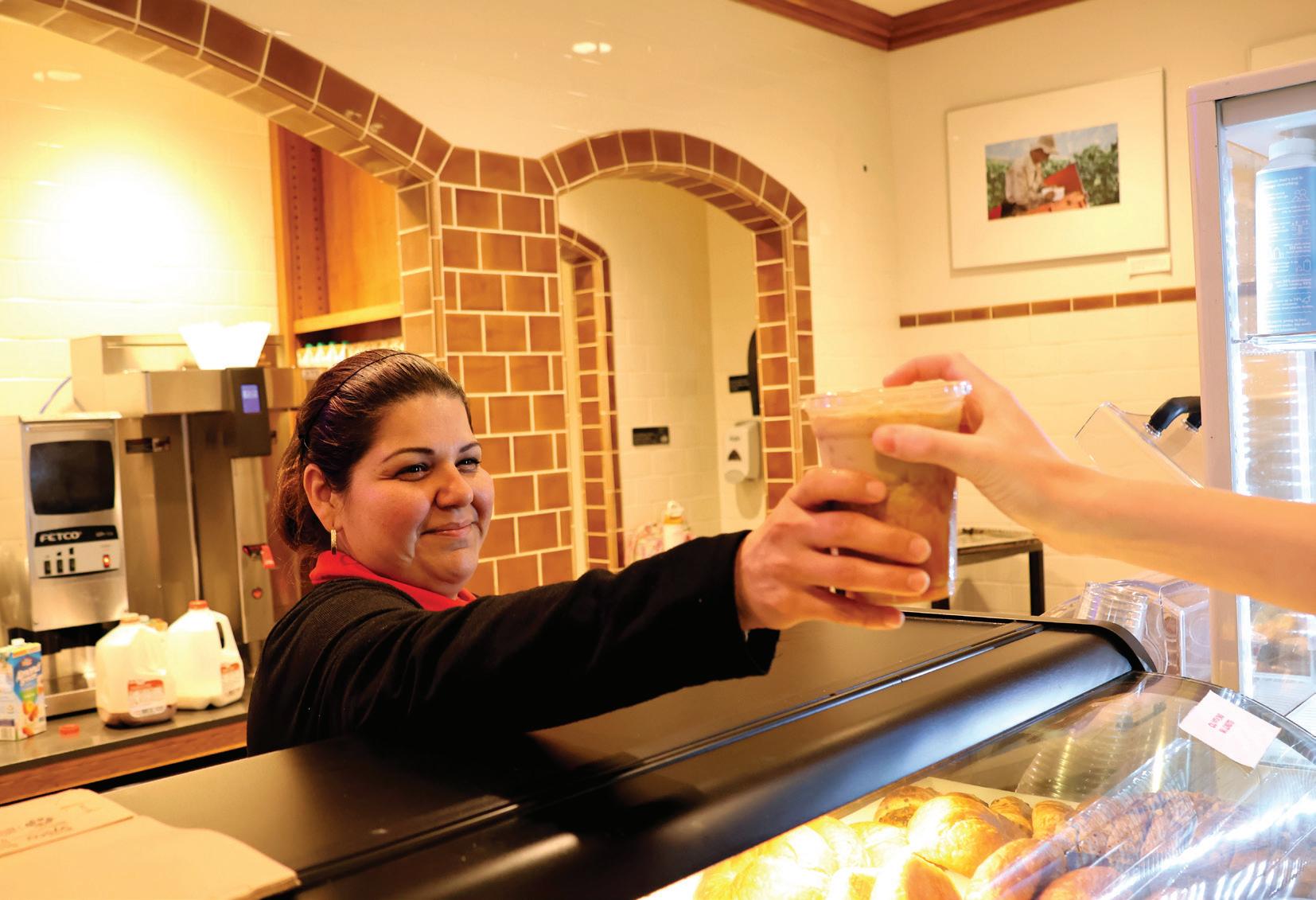








Massive generator provides temporary electricity while repairs are made to system
Story by Mikail Khan
After a power outage struck the Lower School on Wednesday, Aug. 21, the facilities sta worked urgently to return power to campus.
On Aug. 31, maintenance sta disconnected the generator powering the Lower School from the parking lot. By late afternoon on Sept. 1, power was restored, and sta removed the generator from campus on Sept. 3.
Following the malfunction, the School installed a brand-new switchgear, a centralized collection of electrical devices containing circuit breakers, fuses and switches. The switchgear protects and controls power systems. Richard Still, director of Safety and Facilities and Physical Plant, ordered new parts to replace the damaged electrical system.
The facilities sta also replaced the busbar, which conducts electricity and transfers it to multiple electrical devices. The busbar improves system productivity by distributing and transporting electricity.
Once the new equipment was delivered and connected, 10 electricians worked to redirect the power to the brand-new busbar and switchgear over Labor Day Weekend.
Prior to the second day of school, the administration and facilities team spent days attempting to solve the unexpected power issue. The Lower School shut down on Wednesday, Aug. 21, and some athletic practices were canceled.
The temporary solution was to install a generator, which was set up in the Lower School lot. Worldwide Power Products provided a 90,000-pound generator to supplement both the athletic center and Lower School’s electrical systems. The engine consists of refurbished generator sets from old data centers or basements and is currently stored in an 18-wheeler.
“Worldwide Power Products scheduled trucks around the city to pick up distribution gear and cables needed to bypass the burned electrical gear and supply power,” said Jack Crawford, older brother of junior Gracey Crawford. “An 18-wheeler was then sent to our o ce to collect the generator and bring it to SJS from our o ce — everything was on-site between 4:30 to 6:00 p.m.”
The machine was hooked up to the school in less than 12 hours, permitting Lower School students to come back for the third day of school.
The generator was placed close to the frayed equipment by connecting cables to their distribution gear and served as the Lower School and athletic center’s main source of power for 10 days until it was disconnected and removed from campus the day after Labor Day.
One of the di culties of restoring the power was that the facilities team could not work on xing it during the school day, since sta did not want to shut o power when students were on campus.
“The work has to be done on a weekend or at night because we don’t want to take any chances with the power,” facilities manager Salvador Aquino said.
Since the power has been restored in the Lower School and athletic facilities, everything is now running smoothly.

A previous version of this story ran on the Review Online on Aug. 29.

Story by Genevieve Ederle


When Hurricane Beryl began its destructive path across Texas on July 8, one might have expected to nd Richard Still, the Director of Safety and Security and Physical Plant, in the same place as most Houstonians: hunkered down in his home, trying to manage without electricity. Instead, Still spent the night in the Upper School o ce, waiting to assess the damage.
Still’s job involves working behind the scenes to ensure that the School runs smoothly — even in the midst of a natural disaster. Once the storm passed, facilities sta members Byron Ortiz, Marco Gonzalez, Jose Flores, Marco Flores, Ruben Hernandez, Carlos Chavez and Salvador Aquino came to campus, beginning weeks of restoration.
ter, but I still knew that I had to be here.”
For weeks, the cleanup team worked between 12 and 16 hours. The drive to campus was arduous due to ooding, fallen trees and other road hazards. “Normally, during working hours, it takes me around 30 minutes to drive to work, but then it took me an hour,” Aquino said.
The crew cleared so much debris from campus — about 450 square yards each day — that the facilities sta had to purchase more dumpsters.
We never accept a weather report at face value; we have to be prepared all the time.
“All of the facilities sta had power issues and damage to their homes in some form or fashion but dutifully came in to get the School operational rst,” Still said.
Thanks to their e orts, Flores Hall was open for ve days, beginning July 10, so community members a ected by the storm could have access to air conditioning, the internet, water and ice.
RICHARD STILL
“We prioritize being operational. When we get to that point, we then deal with the items that do not a ect the ability to accept students to campus,” Still said.
The facilities sta spent the night before the storm placing barriers in front of buildings prone to ooding. After everyone else went home, Still settled in for a long night.
“It is important to monitor the event in real time,” Still said. “While doing so, I can possibly avert damage or limit it.” Just prior to the major winds hitting the area, Still shut down all unnecessary electrical items, including lights, air conditioning, refrigerators and TVs, leaving only emergency lighting on.
On the rst day after the storm, the sta arrived at 7 a.m. and worked until 10 p.m., breaking down fallen trees and clearing debris as well as performing more technical tasks like locating contractors to assist in repairs.
The most signi cant destruction on campus included fallen trees in Caven Lot and on the Quad as well as damage to the roof, air conditioning units and other equipment.
The facilities crew prioritized restoring campus over addressing their own situations at home. “These guys, even though they had damages to their own homes, were here,” Aquino said. “I didn’t have any power or wa-
Cleaning up after Beryl cut into the time typically reserved for readying campus for the upcoming school year.
“What we normally do in summer is prepare the School for classes – going room to room, painting, making sure everything is set for next year,” Aquino said.
Even after a lengthy clean-up e ort, the facilities team is still dealing with the aftere ects of Beryl. “It seems like everything is back to normal, but we still have two or three things to work on,” Aquino said.
More recently, Hurricane Helene formed quickly in the Caribbean before making landfall in Florida on Sept. 25. Natural disasters form quickly and always pose a threat to campus maintenance, yet each time, the facilities team has risen to the occasion.
“We never accept a weather report at face value; we have to be prepared all the time,” Still said.

First major construction project in 6 years expands, upgrades athletic facilities
Story by Bella Dodig & Aien Du

Most years, when students return from summer vacation, they are greeted by familiar sights: the bustling Lower School playground, the sun-soaked Plaza and the expansive Great Lawn. This year, a eet of cranes and construction equipment signaled the impending arrival of new athletic facilities including tennis courts and a softball eld.
After securing roughly $3 million in funding from various community donors for the project last year, the School nalized plans with Forney Construction, a Texas-based architectural rm. Once the School evaluated the project’s feasibility in June, it launched the rst major project since the Upper School library was transformed into the Academic Commons in 2018.
Forney Construction has recently begun laying the groundwork for the six courts and eld in the green area beside the Taub parking garage, which the School expects to be completed just in time for the spring athletic season.
For the most part it’s been going great. We’re expected to be done right on time.
GREG SWAN
“For the most part it’s been going great,” said Greg Swan, who retired in June as the Chief Financial O cer. “We’re expected to be done right on time.”
Softball coach Isis Amao was involved in the design of the new eld along with athletic director David Cohn.
“Coach Cohn was nice enough to let me sit in and listen to the conversations as the changes were being made,” Amao said. “I am super grateful to St. John’s for giving us this opportunity.”
Last year, the softball team practiced on the eld adjacent to the new gym. Because the eld did not have lights, the Mavs were frequently dismissed early from classes to avoid playing in the dark.
“We missed school for both home games, which had to be scheduled earlier, and away games, which we had to drive to,” sophomore pitcher Ally Hong said. “Missing that much school made it di cult to catch up on work.”
The old softball eld featured a removable out eld “wall” made of mesh that did not reach the ground — resulting in ground rule doubles rather than balls in play that could be elded by out elders.
During softball o season, the eld was also used for Middle School recess, which resulted in bent poles and damage to the eld. The new construction will nally give the team their own eld, featuring overhead lights and batting cages.
“This is such a big moment for the girls and the softball program in the future,” Amao said. “I have been looking forward to this for such a long time — basically ever since I came to St. John’s in 2008.”
The tennis program will also receive long-awaited courts. Since the replacement of the School courts with the Coach’s Lot, the tennis program has practiced at o -site facilities. Recently, teams have practiced at Rice University, the River Oaks Country Club, the Houston City Club and Pumpkin Park.
Commuting between school and courts ultimately shortened practice time, forcing Coach Zeze de Moura to cut practice to one hour, limiting player development.
“We do not even have time to warm up or cool down after practice,” de Moura said.
According to de Moura, the new courts will allow younger players to develop their game before they reach Upper School.
Across Bu alo Speedway at Scotty Caven Field, the former maintenance building is being renovated to become the Angie Kensinger Center, an easily-accessible training building featuring a
conference room and storage space. The building is named in memory of the beloved girls’ lacrosse coach who died in a 2019 plane crash.
“We have always wanted to do something to honor her,” Swan said. “At the same time, we wanted something that would be useful for the athletes and the school.”
The Kensinger Center’s development, he added, “has been a time-consuming but really positive process.”
I am incredibly proud to be associated with this. I am just a worker bee and have loved my 20 years at St. John’s.
GREG SWAN
The project has required countless hours of work from administrative sta , school liaisons and construction crews alike. Their e ort has paid o , according to Swan.
“We have been working on this for around three years and are exactly where we want to be,” Swan said, adding that the projects should be done by the end of December.
Swan, who spearheaded the project, has contributed to many endeavors during his time at the School, including the construction of the Great Hall, the Great Lawn and the Fine Arts Annex. Throughout his career at SJS, Swan oversaw roughly $150 million in funding.
Despite his retirement, Swan still plays a key role in the ongoing construction, coming in every Monday to check up on the progress and attend meetings as the School’s liaison.
“I am incredibly proud to be associated with this,” Swan said. “I am just a worker bee and have loved my 20 years at St. John’s.”
Story by Aleena Gilani & Neve Meredith
In March, roughly 770,000 students across the country logged on to take their rst digital SAT. Just minutes after students were released from testing rooms, they ooded the SAT subreddit with negative comments.
One user said that the SAT “made me want to throw my computer in the garbage.” Another lamented that it “wiped the oor with me.”
On the digital SAT, both sections are split into two modules of equal length. Students directed most of their anger toward the second modules of each section — the di culty of the second modules depends on how the student performs in the rst ones. Because of adaptive testing, the digital SAT takes two hours, an hour shorter than the paper-and-pencil version.
Unlike many Redditors, senior Annie Villa, who waited until June to take her rst SAT, prefers the changes that College Board made. “I just knew that I would do better on the digital SAT,” Villa said. “So I just completely held o until I knew I could take the digital one.”
While Villa was initially apprehensive about taking the digitized test, she changed her mind after learning that the test would have shorter reading passages and give access to Desmos, an online graphing calculator.
Senior Katie Czelusta, a Review editor, says that she is partial to the print SAT for myriad reasons. For Czelusta, it was the little things, like writing on the margins of passages, that led her to prefer pencil and paper.
To help students prepare for the digital SAT,
College Board added multiple full-length practice tests to its app, Bluebook, in 2022. Practice tests are meant to simulate the di culty of the actual digital test; however, most users on Reddit found the Bluebook practice far easier than the real deal.
“The English was comparable, but the Math was just completely di erent from the practice ones that they o ered,” Czelusta said, adding that the Math questions on the digital SAT were “ten times harder.”
Villa says she performed better on the actual SAT, noting that Bluebook is “a pretty mixed bag.”
Following the March 9, 2024 test, College Board announced that a whopping 84% of students “reported a better experience with the digital SAT Suite compared to the paper SAT Suite” — a stark contrast to the number of complaints on social media. They also shared that the “overall performance” of March 2024 test-takers was comparable to the performance of students who took paper tests.
In January 2022, College Board announced that the SAT would shift to digital in the United States by 2024. In February 2024, the ACT also began of-
fering a digital version at select testing locations.
While students like Villa have embraced the digitization of standardized tests, the switch poses a wide range of issues for under-resourced schools. College Board requests that students bring their own laptops to testing centers — if students do not have a device, they can loan one.
Even if students can secure a laptop for test day, at-home preparation for the SAT can still be a challenge. Most of the practice that College Board o ers is digital, making it di cult to access for students without a device or stable internet connection. College Counselor Tanya Cummings says that, as a result, the digital SAT “does not really help for accessibility or equity’s sake.”
“When I think about public schools, they do not have the resources or laptops. Or if they do have laptops, they’re outdated,” Upper School Academic Support Coordinator Karina Soto said.
Cummings says that testing centers in rural areas could also have issues with broadband or Wi-Fi on test days. Overall, though, Cummings agrees with College Board’s decision to go digital.
“People rarely write things anymore. You rarely see people handwriting a letter,” Cummings said. “It’s called quaint now because everything is being digitized and done electronically.”
Cummings predicts that college admissions o cers will eventually start seeing changes in score trends as a result of the switch. “Three or four years from now, we’ll see the average SAT scores actually get higher than what they used to be ve years ago.”




Story by Aien Du and Rian Du
As the sun dipped below the horizon of the Moroccan coastline, Marquita Gill took in the moment. She had spontaneously paused her journey from Marrakech to Essaouira to admire the view of the Atlantic Ocean when some locals asked if she wanted to go for a ride. She spent the next half-hour exploring the area atop a two-humped camel.
Gill’s passion for travel influences her choices in her English classes. She infuses her lesson plans with global cultures and introduces a wide variety of literature to give her students the opportunity to see themselves in the reading.
Her lesson plans sometimes inspire her future travels. For instance, when teaching the Colombian short story, Gabriel García Márquez’s “A Very Old Man with Enormous Wings” in English I, Gill began imagining a possible Colombian adventure.
Gill makes connections between her travel experiences and her approach to teaching.
“Lessons are important, classes are important, but the connections I form with my students are what helps them remember and enjoy the school experience,” Gill said.
The pressures and unpredictability of travel have made her sympathetic to her students’ hectic schedules.
“I understand the stress and hustle my students are going through,” Gill said. “Whenever they need a break, I make sure to hear them out.”
Students say Gill also makes it a point to foster a purposeful relationship with her students, getting to know them on a personal level.
“Within one day, she knew about my cat Isabella and my favorite SZA album,” sophomore Allison Lu said.
In just two years, Gill has thrown herself into campus life, signing up to sponsor the Black Student Union, Black Girl Coalition, Women of Color Affinity Group, Boba Tea Club, Henna Club and Quiz Bowl. She also serves as Class 9 Chair and a Junior Summer Internship Liaison.
Gill’s curiosity and energy has translated into
An SJS teacher, parent discuss experiences as flight attendants
Story by Yutia Li & Katharine Yao
From mid-air medical emergencies to unruly passengers, flight attendants have one of the most demanding jobs around. Few know this better than St. John’s parent Angela Perry, a veteran flight attendant of 32 years, and English teacher Kim Roquemore (‘87), who spent six years with Continental Airlines.
Back in the 1990s, after teaching English and working for a nonprofit in Michigan, Roquemore wanted a change of pace. “It was one of those times in my life when I just needed something completely different from what I was doing,” Roquemore said.
Roquemore soon found herself attending a six-week training camp in Houston, where she participated in evacuation simulations and took weekly written assessments over topics ranging from airplane structure to the onboard menu.
“The intensity took me by surprise, especially being a St. John’s student,” Roquemore said. “We learned a lot of stuff that you wouldn’t think a flight attendant who’s

time spent traveling. This past summer was no exception.
Gill began her most recent escapade in Monterrey, Mexico, to celebrate her birthday in May. She then visited Chicago, New York, Barbados, New York again, and finally a tour of Europe and North Africa including Portugal, Spain, Morocco, Italy, Malta and France.
Despite her frequent travels, Gill’s heart remains in Barbados, where she was born and raised.
Gill regularly recruits students to work the Barbados booth at the International Club Fair. Last year, the booth featured a display including a map of the island, famous Barbadians, interesting places and traditional delicacies like pone, a coconut dessert, and non-alcoholic ginger beer.
“Barbados is always number one for me,” Gill said. “Houston is just my workplace.”
Although Houston’s hot and humid weather is reminiscent of the climate in Barbados, for Gill, the similarities end there.
“The accents are different. Even the words we use are completely different,” Gill said. “I have to code switch and soften my accent so that people can understand me.”
The culture shock of moving to Texas took a few years to wear off, but eventually she got the hang of it.
When considering which country to visit next, Gill has certain criteria: She prefers warm weather, beaches and nature.
serving you water or Coke would know.”
Roquemore did not fly a set route during her first few years on the job. Typically, she would step in to replace other flight attendants who had fallen sick or gone over the amount of time they were legally allowed to fly that day, all with just two hours’ notice.
Because Roquemore was usually “on call,” she frequently flew on holidays. One year, she spent a Christmas layover in New Orleans with the flight crew.
“I was dancing and eating and singing with people I had never met before,” Roquemore said. “It was really fun to bond on that level instead of being so sad because you’re not with your own friends and family.”
Today, Perry has the seniority to choose her own route and flight frequency. A world traveler who speaks Italian and Spanish, Perry flew a monthly route to Rome or other Italian destinations for 26 years.
Having flexibility helps her keep up with her two children, Caden (‘23) and Addison, who is a junior.
Perry loves her job because it allows her to experience countries in ways that most people cannot.
“I’ll search for a donut shop and wait in line for two hours for a donut. You can’t do that on vacation because you’ve got ten other things on your list,” Perry said.
For her tenth birthday, Addison flew from Newark to Rome with her mother. “I was sitting in the back by myself and she was serving me drinks,” Addison said. “It was really cool.”
Because of her mother’s job, Addison has traveled to six of seven continents at a fraction of the usual cost —
Her last destination that checked all the boxes was Malta.
Using Duolingo to practice Italian, Gill applied her new language skills, improving her Italian while forming deeper connections with the people of the island. The southern European nation appealed to Gill beyond the possibility of Italian language practice. A pescatarian, Gill could easily find fresh fish and seafood. Gill explored Malta like a local, venturing on boat rides to the neighboring islands of Gozo and Comino, visiting local churches and relaxing on the beach.
Gill has picked up some key pointers for travel abroad. First is flexibility and next is spontaneity. Finally, she tries to go beyond the usual.
“I do not like to be touristy,” Gill said. “I try to live like the locals.”
While she occasionally visits the must-see landmarks, Gill finds the deep dive into a place much more fulfilling.
“It might not be ‘pretty,’ but at least you get to learn more about the country’s culture and people,” Gill said.
Although it has only been a few months since she has returned from her summer travels, Gill is already planning her next trip. Inspired by Márquez’s short story, during Thanksgiving break, Gill will be soaking up the sun in Cartagena, Colombia.
“Traveling is my source of joy,” Gill said. “It makes me feel more connected to people.”
flight attendants and their families can fly free on standby. Addison recalls that during Thanksgiving break, her family used to pack their bags, head to the airport and hop on any available flight.
“We didn’t know where we were going until we got to the airport,” Addison said.
While Perry still flies a monthly route to San Francisco, Roquemore resigned from Continental in 2005 to take care of her daughter, Zoë Olan (‘24). Before returning to St. John’s in 2013, Roquemore started her own tutoring and educational consulting business and taught online college courses.
Roquemore still cherishes the relationships and memories from her time flying the friendly skies.
“It was perfect for me at that time in my life.”

Story by Aila Jiang

Hayden Kramer swears he is not an adrenaline junkie — but he has jumped out of a plane almost 50 times.
Last July, one month after he turned 18, Kramer unofficially became the youngest licensed skydiver in the world. He celebrated his birthday by performing his first tandem skydive, strapped to someone else’s stomach.
“It felt cool, so I decided to get my license to jump out of planes myself,” Kramer said.
While he was in Ohio for a summer internship, Kramer went to the local drop zone to fulfill the required 25 solo jumps for his US Parachute Association Class A license. Within one month, he completed all necessary training and exams, allowing him to skydive by himself anywhere in the world.
“It’s pretty calm and relaxing. It’s not much of an adrenaline rush,” Kramer said. “Once you do it many times, it isn’t different from any other activity.”
Kramer claims that his interest in the extreme sport seemed to appear out of thin air. After indoor skydiving at iFLY for the first time in 2022, he found out that he was “pretty good” at it, so he began going twice a week.
iFLY hosts the annual US Indoor Skydiving Nationals, typically in Colorado Springs. This November, Kramer will compete in the solo speed event, in which entrants complete a pattern as quickly as possible.
It’s pretty calm and relaxing. It’s not much of an adrenaline rush.
HAYDEN KRAMER
Kramer credits skydiving with his interest in aerospace engineering, a field he intends to pursue in college. He is currently enrolled in the Engineering Capstone course and is considering building planes as a career, which is ironic considering he would rather jump out of them than fly in them.
“If you’re jumping from 14,000 feet, you have 60 seconds to just fly and fall forward at 120 to 160 miles an hour,” Kramer said. “You’re really just falling in style. There have been times where I’ve flown into a cloud.”
Kramer’s most memorable skydive was in
August when he jumped with an inexperienced skydiver who began flipping out of control and “doing super reckless stuff.” Kramer says that if he got hit by someone at 30 miles per hour while in the sky, he’d “probably be dead.” When it was time to deploy the parachute, the other diver was right beneath him.
You’re really just falling in style. There have been times where I’ve flown into a cloud.
HAYDEN KRAMER
“He could have killed me, so I got away from him as fast as possible during that jump. It was super nerve-wracking,” Kramer said.
Kramer says that the biggest challenge for any skydiver is “not being an idiot.” To ensure he does not become a statistic, he researches skydiving-related fatality reports and watches videos of mid-air collisions.
“I trust him to be pretty safe because I know he is smart,” said senior Connor Campbell, Kramer’s friend since first grade. “I just don’t understand why that’s his hobby.”
Kramer says that exiting the plane and freeflying are the most difficult skills to master. During the school year, he hones his freeflying skills and practices different body orientations in a wind tunnel. Kramer tries to go skydiving at least once every weekend at Skydive Spaceland Houston, a drop zone 25 minutes from his home.
“Houston has one of the best drop zones in the world,” Kramer said. “There is a nice open area for landing, a lot of instructors, a really good weather system and good pilots — everything’s a safe run.”
Thanks to Skydive Spaceland’s resources, Kramer has not felt the need to skydive elsewhere, but he hopes to jump over the mountains in Switzerland one day. As he moves towards hitting his 50-jump milestone, Kramer has fulfilled almost all the requirements for a Class B license. When Kramer initially told his family that he wanted to get a skydiving license, they were not surprised. Though apprehensive at first, Kramer’s mother got more comfortable with the idea once he turned 18 and began jumping more frequently. His brother Dylan, a sophomore, said, “He’ll do all the craziest things: he does bungee jumps when
we go on trips, and in Switzerland he jumped off a 200-foot cliff.”
His friends are equally impressed by his skydiving accomplishments.
“It was crazy because it would never cross my mind to go and get my skydiving license when I turn 18,” Campbell said.
Kramer recommends performing a tandem jump for those interested in skydiving. But he has yet to convince any of his friends to go.
“He would be the only reason I’d go skydiving,” Campbell said. “I would never actually want to, but I might do it just to be nice to him.”
SKYDIVING BY THE NUMBERS
3 MONTHS AS A LICENSED SKYDIVER
46 SOLO JUMPS COMPLETED
14,500 feet
AVERAGE HEIGHT OF EACH JUMP
15,000 feet
MAXIMUM JUMP HEIGHT
160-180 mph
SPEED FLOWN
As a company member of the Alvin Ailey American Dance Theater, Isabel Wallace-Green (‘15) seeks to inspire social change
Isabel Wallace-Green (‘15), company member of the Dallas Black Dance Theater Company for two years, left in 2023 to become part of the legendary Alvin Ailey American Dance Theater, the pinnacle for any aspiring dancer.
The remaining members of the DBDT voted to unionize on Aug. 9, 2024. Two days later, they were all red. On Instagram. In the same post, DBDT announced open auditions.
The Dallas company claimed that the termination was due to a “vulgar” Instagram Reel that the dancers posted. But the video, which showed the dancers shimmying to the “Family Matters” theme song, did not resemble the misconduct that the company claimed. It became clear to those following the story that the dancers had been targeted for their attempt to unionize.
“I stand with the dancers and I believe dancers everywhere. Regardless of how large their companies are or how small, the dancers have the right to be in conversation with management about their working conditions,” Wallace-Green said.

we’re going to do it, we’re going to do it right,’” Wallace said, so on the day of auditions, she woke her daughter in the middle of the night and drove to the Houston Ballet Academy on Bell Street so they would be one of the rst in line.
After being accepted, Wallace-Green’s legs hurt so much that she wanted to quit. But her mother had already signed her up for the year, so she agreed to stick it out for a few more months. By November, she had fallen in love with ballet.


Dallas City Councilman Adam Bazaldua called the mass ring “textbook union busting” and called for an investigation. Protestors rallied outside their theater in downtown Dallas, calling for the dancers to be reinstated.

According to Wallace-Green, people are watching and learning from the steps being taken by the union and management. “It seems as if all eyes are on Dallas right now.” She posted a statement about the incident to her Facebook page.


Wallace-Green is particularly interested in the intersection between art and social justice in her career. “When audience members leave our performances, they leave a little bit more open than they were when they arrived. That, in a trickle-down e ect, allows people to then go into their separate spheres and operate with a more giving self and with a more understanding self,” she said. “I feel like even though it’s not the work that’s necessarily doing the systematic change, it’s still essential work that allows people to then go out and do that.”
Wallace-Green, who started dancing when she was six, is entering her second year with Alvin Ailey.
Her mother, Susan Wallace, taught art at St. John’s and enrolled her daughter in a dance class taught by former SJS dance teacher Susan Sanders.
“Teaching Isabel as a young child and observing her respond to her movement work, I was immediately struck by her natural inclination for movement,” Sanders said. “Taking note of the level of personal expression that she contributed to her dancing, I quickly sensed Isabel’s passion to dance.”
Wallace-Green was so talented that Sanders encouraged her mother to audition for the Houston Ballet Academy.
“I knew about Houston Ballet, and I had seen the students there perform. I thought, ‘Well, if
“They started out with this very serious attitude from the beginning — none of this cute tutu stu until you perform,” Wallace said. “Her dance teacher used to always say, ‘This isn’t the Dolly Dinkle School of Ballet.’”
Wallace-Green was concerned about performing in both ballet and academics, so she left the Academy sophomore year to focus on her passion for modern dance. She performed and choreographed for Terpsichore, the highest level of dance at St. John’s.
“Because I grew up in a very rigid ballet setting where we didn’t have a ton of performance experience, Terpsichore was my rst chance to try what I consider really fun dancing,” Wallace-Green said.
I’m always trying to get back to that little kid in me who just loved peforming and loved the stage because that was so fearless.
ISABEL WALLACE-GREEN
English teacher Kem Kemp has known Wallace-Green since she was a baby and taught her senior year.
“She’s more than a dancer,” Kemp said. “As a student, as a dancer, as a daughter, she has a lot of depth.”
After graduating, Wallace-Green would cat-sit for Kemp and help organize her classroom whenever he visited. Kemp has seen Wallace-Green perform twice as a professional dancer.
“Everybody has a persona in dance, and hers just comes from within,” Kemp said. “I think her movement embodies her soul and her love of people.”
During her sophomore year, Wallace-Green was dancing on the sidelines of Skip Lee Field during Field Day when she tore her ACL. It would be nine months before she could dance again. “The physicality of it is really devastating, but for most people who experience it, it’s also a mental injury, and it possesses mental blocks,” Wallace-Green said.
After months of physical therapy, she attended Fordham University at Lincoln Center, where she received a BFA in dance and African/African American Studies. St. John’s dance teacher Victo-
ria Azripe helped Wallace-Green shoot audition tapes for The Ailey School at Fordham.
Wallace-Green entered the professional dance world as an ensemble member alongside the Rockettes in the Radio City Christmas Hall Spectacular in 2019, performing up to 16 times per week.
In 2021, she joined the Dallas Black Dance Theater as a company member. Renowned patron of the arts Ann Williams founded DBDT in 1976. Until the rings, the company consisted of 14 professional dancers who perform a mixture of modern, ballet, jazz and ethnic dance. Wallace-Green fell in love with DBDT when she saw them perform during her senior year at Fordham.
“It’s a much smaller company than Alvin Ailey, so it seemed like a good place to get started and to gain experience before embarking on such a larger scale,” Wallace-Green. “It allowed me to gure out for myself what it means to be a professional in this industry.”
After two years, Wallace-Green felt she was ready to audition for the Alvin Ailey American Dance Theater. Her mother remembered how Wallace-Green had seen the company dance when she was younger, and how she was mesmerized by dancers with darker skin performing modern and theatrical dance.
Visionary choreographer Alvin Ailey founded his dance company in 1958 and choreographed one of the company’s signature pieces, “Revelations,” which chronicles Ailey’s African American cultural heritage and memories of his childhood in rural Texas. It has become one of the most seen and acclaimed modern dance pieces in the world.
“It’s a masterpiece, it’s timeless,” Wallace-Green said of “Revelations.” Since joining the company, she performs two of the three main pieces in a show per night while on tour, one of which is “Revelations.”
Touring entails traveling to di erent cities, rehearsing for multiple hours, having class for an hour, and then performing in the evening. Even as professionals, the Alvin Ailey dancers still take classes from a mix of current and retired dancers. When she is not on tour, Wallace-Green lives in New York City.
During time o from the company, Wallace-Green sometimes teaches her own dance classes for youngsters. “I’m remembering that it’s not all about technique. It’s not all about the shapes, but the storytelling is so important and that starts in the classroom,” she said.
Her rst teacher could not be more proud, and recalled “seeing her out on that dance oor, having a blast dancing like no one was watching.”
“I knew then that this was her special gift,” Sanders said.
When Wallace-Green worked with Sanders, she did not experience stage fright but got excited instead.
“I’m always trying to get back to that little kid in me who just loved performing and loved the stage, because that was so fearless.”






Story by Eshna Das, Lee Monistere, Dalia Sandberg Design by Serina Yan & Amanda Brantley
ZYN
is replacing vaping as the go-to
source of nicotine for teens. here’s how it happened.




All student names have been changed to protect privacy. Sources referred to by only one name have requested to remain anonymous.

At a party last fall, Kylie tried ZYN for the rst time. A boy she knew from school had a pack and o ered her a tiny white pouch.
Kylie, who “wasn’t well informed on how to use it,” stuck the pouch behind her upper lip, unaware that it contained the highest nicotine dosage of any ZYN product. Overwhelmed by the e ects of nicotine, Kylie threw up for 30 minutes.
“I didn’t feel anything for the rst ve minutes,” she said. “Then, all of a sudden, I felt really heavy and shaky.”
Kylie has not used a nicotine product since that night.
“It traumatized me so much because I genuinely don’t think I have ever felt that bad,” she said. “I was on the oor crying, asking people for help. I was totally out of it because of how bad it made me feel.”
ZYN is a brand of nicotine pouches with avors such as wintergreen and cinnamon that appeal to teenage consumers seeking an alternative to vaping. ZYN pouches resemble packs of silicate drying agents that come inside vitamin bottles.
Owned by multinational tobacco company Philip Morris since 2022, ZYN is marketed to tobacco users as a safer source of nicotine. Although the pouches do not contain tobacco, regulators still treat it as a tobacco product. Until the Food and Drug Administration can investigate the safety of ZYN, the product remains available for sale in the United States.


of ZYN pouches.


Brian King, Director of FDA’s Center for Tobacco Products, stated in an FDA article:



“There is no excuse for selling tobacco products to any underage person, and FDA will hold retailers accountable for those violations — especially those who continue to do so after being warned.”



An applicant seeking to get their product approved by the FDA must demonstrate that it meets a list of necessary criteria, which includes proving that the product meets legal public health standards.




aul is a regular ZYN user who admits that the drug has become a part of his daily life. “I wouldn’t even say I do it recreationally,” Paul said. “It’s like waking up in the morning






ZYN packets were rst released in Scandinavia by Niconovum, a Swedish pharmaceutical company. The product entered American markets in 2014, followed by brands such as on! and Rogue. Yet ZYN only gained popularity last year. CNN reported that 350 million cans of ZYN were sold in 2023, an annual increase of 62% from the previous year.




ZYN pouches are designed to be placed between the user’s gum and upper lip. “Zynning” was marketed to be more discreet than smoking, so people could get a nicotine hit without drawing unwanted attention.

Amy Malin teaches a semester-long psychology course and has evaluated the social bene ts of ZYN use.






“You don’t have to leave wherever you are to go and get your nicotine x,” Malin said. “You can just do it wherever. Then there isn’t the stigma associated with smoking, and there also isn’t secondhand smoke.”


Recently, ZYN has gained massive popularity online, exploding on social media platforms like TikTok, with “Zyn uencers” accumulating almost 300 million views.

ZYN has also reached the athletic world. “If I scroll for a while, I’ll probably see an athlete with ZYN,” said Vince, a junior. “Just the other day, I saw Bills quarterback Josh Allen doing ZYN on Instagram before a game.”

If you take it regularly, those withdrawl symptoms feel like you’re depressed and anxious.
AMY MALIN PSYchology Teacher
The FDA has issued 119 warning letters and led 41 civil money penalty complaints against brick-and-mortar retailers that have sold avored ZYN pouches between October 2023 and February 2024. The FDA has also warned three online retailers regarding the sale of unauthorized avors






Paul goes through one pack of ZYN — which holds 15 pouches — in three to four days. He credits ZYN
and taking ADHD medicine.” for helping regulate his emotions.
“I feel lightheaded, but not in a dehydrated way,” he said. “My senses are slightly heightened, but my
Paul says that ZYN has its own unique bene ts. “It’s the healthiest way to put nicotine in your body.” Vince, a multi-sport athlete who has never done ZYN, has observed the phenomenon and considers it a replacement for other tobacco products. “Sportswise, it’s kind of an accepted thing,” he


Upper School counselor Jake Davis is familiar with the e ects of ZYN through his conversations with students. He notes that ZYN is being advertised as a wellness product.






“For a long time, they have marketed to teens by trying to create avors that seem enticing and fun,” Davis said.




“Now, it seems like it can be a version of self-care, which is very dangerous.”




In 2024, a lawsuit was led against ZYN, claiming that Philip Morris was marketing and selling their product without appropriate nicotine warnings.

In September, the City of San Francisco led its own lawsuit targeting several online vendors accused of avoiding laws aimed at preventing kids from getting addicted to tobacco products.




I wouldn’t I do it recreationally. It’s like waking morning and ADHD medicine.

Grayson often notices that his friends choose to use ZYN at parties over harder drugs in social settings. He credits this trend to the stigma surrounding vaping and how it is considered “unacceptable because people know
Grayson has witnessed a group of boys pressuring a friend to use ZYN, calling it “a bit of a problem.”
“It’s di erent when you’re not being pressured because then at least it’s your decision,” Grayson said. Grayson’s friend doesn’t drink or want to do drugs.
“It’s not good that he is being put into a position in which he has to compromise his values.”
Most ZYN-stances occur at parties, yet some choose to use it in more casual settings. Isaac used ZYN for the rst time while hanging out with

body feels really calm.” of ZYN, you’re considered tougher.” how bad it is.” friends.
“We didn’t have anything to do,” he said. “So we just walked to the park and did it.” When he tried it for the rst time, he felt dizzy and exhausted. “It feels like you’re out of it,” Isaac said, “but it’s enjoy-
able — I would do it again.”



The human body absorbs nicotine through mucous membranes within the inner lining of the mouth and directly into the bloodstream. The e ects can last up to
one hour.

Paula Angus, who teaches Neuroscience and Anatomy, explains, “it goes right through your skin. Here, it’s going to be delivered even faster because it’s a moist surface. It’s very thin, and it’s packed with blood vessels.”
Once in the bloodstream, nicotine stimulates the adrenal glands, resulting in the discharge of adrenaline, which causes an increase in blood pressure, respiration and heart rate.





“They certainly seem to be safer than tobacco cigarettes,” said Ashley Dowd, a postdoctoral research fellow at Johns Hopkins University who was quoted in a Time online article published in January. “But having a general sense that they’re safe would concern me, especially if it prompts people who don’t currently use nicotine to pick up a pouch thinking it’s harmless.”
The School Handbook states that the use or possession of tobacco or nico-


Tobacco companies benefit from having lifelong customers, so it’s in their interest that teens become addicted to using their products into adulthood.
“In terms of your health, it’s worse based on how fast it’s going to deliver and how much nicotine you’re going to be exposed to at any one time,” Angus added.
Short-term e ects of ZYN usage include hiccups, gum irritation, upset stomach and sore throat. In the long term, nicotine use during adolescence can disrupt the formation of brain circuits that control attention, hinder learning abilities and increase Malin explains that, as the brain develops, it makes connections between neurons using an ideal level of chemicals that the body naturally produces. Using drugs upsets the brain’s natural chemical balance and may disrupt levels of acetylcholine and dopamine.
even say recreationally. waking up in the and taking medicine.

susceptibility to addiction. like


“If you take it regularly, then when you’re not taking it, those withdrawal symptoms feel like you’re depressed and anxious,” Malin said. “You have di culty concentrating and feel like you can’t focus.”

Angus further explains that, at any age, the brain is still changing due to its plasticity. For teenagers, nicotine hijacks neural pathways, in uencing the development of other regions of the brain and leading to addiction.
Both the FDA and Environmental Protection Agency have designated nicotine as a noxious substance. “So in that ZYN packet there, there’s a little bit of hazardous waste,” Malin said. Recently, ZYN’s surge in popularity has cut into vape sales. According to the Federal Trade Commission, the sale of all oral nicotine products more than doubled from 453 million in 2021 to 1 billion in 2022.

tine products on campus or any school-sponsored activities infraction, which includes one or more work halls, disciplinary watch.
is a Level 2 disciplinary in-school isolation or

Dean of Students
Bailey Duncan urges students to seek help if they are facing substance abuse.

amnesty clause, and we’ll get them help versus them getting in trouble,” Duncan said.
Davis notes that warning students about the harmful e ects of ZYN is particularly important.

“This generation of teens is experiencing mental health challenges at a higher rate than most generations that came before them,” Davis said, “They’re especially vulnerable to products like these that have really never been more powerful and more dangerous. And tobacco companies bene t from having lifelong customers, so it’s in their interest that teens become addicted to using their products into adulthood.”
Malin urges teenagers to be more aware about the consequences of drug use.
“The way you think about a substance is going to in uence your use of it,” Malin said. “I know we can be curious about things, or we feel like everybody else is doing it. Pause. Do a little research.”

“If a student is struggling with something substance-related, they can ask for help, almost like an at said. just
334 million total growth in cans sold by Zyn over 6 years

$16 billion aquisition price for ZYN by Philip Morris in 2022

Kylie encourages others to learn from her mistakes.
“It’s really, really important to do your research, or you could end up in a situation like I was,” she said. “You’re going to go to a party and a ton of kids are going to be using it because that’s the culture. And if you want to do it, that’s on you. But just know what you’re getting yourself into.”
Source: Public Health Law Center Bloomberg
641% increase in ZYN sales from 2019 to 2022
American Lung Association













































































































































On her rst day of junior year, Elliana Faykus found herself stranded in the middle of Rennes, France with no phone and just a paper map. For the next two hours, she and her new classmates explored the city. They had to nd their way back to school by asking for directions in French and learning how to use the local metro system.
Faykus is spending the entire academic year in France as part of School Year Abroad, a program a liated with the School, which has campuses in France, Spain and Italy.
When Faykus rst heard about SYA, she was put o by the amount of paperwork required. “I saw the application and didn’t know if I’d stick with it,” she said. “Now that I’m here, I don’t regret my choice at all.”
Despite missing her family and friends, Faykus says she looks forward to creating new memories with her host family. “Every Friday night, we have a tradition of watching a movie and cooking together. It’s something I’ve come to cherish,” she said.
As a younger sibling, Faykus was nervous about being an older sister to her younger host brother and sister, who are ve and seven years old. Now, Faykus has found connections with her host siblings by shopping, going around Rennes and
spending quality time with them.
At SYA France, Thursdays are dedicated to “experiential learning” — a time for students to visit the historic sites they have been learning about in the classroom. In mid-September, Faykus walked 8.5 kilometers (a little over ve miles) to Mont Saint Michel, an 8th-century abbey in the Normandy region that sits in the middle of frigid water and quicksand on the coast of the English Channel.
I saw the application and didn’t know if I’d stick with it. Now that I’m here, I don’t regret my choice at all.
ELLIANA FAYKUS
“We were all just clinging on to each other and slipping in the wet sand,” she said. “It was a bonding experience for all of us.”
Each day Faykus takes a bus and two metro trains to get to school, and getting lost is easy. On her rst day of school, Faykus was over 30 minutes late after taking the wrong bus twice.
“It’s just about timing it right and leaving yourself extra time for something to go wrong,” Faykus said.
During her year away, Faykus anticipates

becoming more independent and con dent in her speaking abilities. “The goal is to obviously become more uent in French but to also learn about myself and gure out what I want to do in college.”
Shelley Stein (‘88), Faykus’ former French teacher, has no doubt that she will achieve her goal. “In the past 15 years of teaching here, I’ve had ve or six students go to Rennes, and they all come back sounding like French teenagers,” Stein said.
Faykus was excited about going to Rennes, but for her parents, it was a di erent story.
“My mom was really worried, so we ended up going to France a little early and she got to meet my host parents,” Faykus said. “Once she met them, she de nitely felt better about leaving me halfway across the world.”
SYA encourages students to minimize contact with their friends and family back home — though the recommendation may sound harsh, it helps students connect with their new community.
Since 1964, SYA has sent American students to Europe. After a hiatus during the global pandemic, the program is once again providing opportunities for students looking to immerse themselves in a foreign culture.
Last year, Amelia Earle and twin sisters Pia and Tess Artzer spent their junior year in Zaragoza, a city in northern Spain. They shared their stories with the Upper School during an assembly on Sept. 19, where all three students emphasized the pivotal role their host families played in their experiences.
Tess connected with her host mother through their shared love of nature, weekend hikes and trips to the mountains for fresh spring water — her host family refused to drink from the tap. Even though Earle’s host family did not speak any English, “they were really sweet and patient.”
Pia did things she never imagined she would do, like translating for the women’s basketball team in Zaragoza for her host sister and taking an impromptu trip to the Pyrenees mountains with her friends. She lived her own “just say yes” challenge, a pillar of SYA, every day: “I wanted to embrace every moment I could.”
Now that Tess is back in Texas, she is working to apply the lessons she learned in Zaragoza.
“It’s hard to leave such a good thing behind and readjust to St. John’s rigor again. It’s a balance between the sadness of leaving and the happiness of coming back to home.”






























It is time to say goodbye to brat summer. It’s not that we’re tired of it. We eagerly await Charli’s remix album and are following her tour with Troye Sivan, but the fact is, it’s fall now. For a somewhat smooth transition into what will inevitably be a brat autumn — a bratumn, if you will — we offer the following recommendations. We looked for powerful albums penned and produced by women. Green album covers were just a perk.
“PICKPOCKET”

By Lucy Walker
Eliza Hardy Jones has been busy. Her second solo album, “Pickpocket,” self-released in April, is a meandering folksy masterpiece guided by Eliza’s struggle with infertility. She began writing the album several years ago after one of several miscarriages, and recording in the studio was the rst many of her friends and collaborators heard of her journey. This year, she welcomed a baby boy, Al e, into the world. Eliza is a member of both The War on Drugs and Buried Beds, and her husband andrew is a former member of indie rock project Dr. Dog.
“It’s a really interesting thing to have written something to help myself be at peace with not being a mom and just having my life be the way that it was,” she said in a Zoom interview this Spring. “But then having the opportunity to do it anyway is really fun.”

By Serina Yan
Claire Cottrill, known professionally as Clairo, burst onto the music scene in 2017 with the self-produced bedroom pop hit “Pretty Girl.”
Following the 2019 LP “Immunity” and the 2021 release “Sling,” Clairo’s third full-length album, “Charm,” was released in mid-July. “Charm” is understated yet lush — Clairo’s soft, breathy vocals are punctuated by whimsical ute and lilting piano, producing a warm, groovy sound that seamlessly blends jazz, 70s soft-rock, and psychedelic folk. Lyrically, the album is just as intimate, exploring the complex emotions of new relationships and old heartbreak, the nuances of love and self-discovery.
On “Charm,” Clairo is at her best, e ortlessly combining the irtatious hooks of “Immunity” and the emotional vulnerability of “Sling” to create a layered, sophisticated album over owing with, well, charm.
Story by Amina Khalil-Zegar
Over the summer, the girls’ cross-country team spent their last night in the nation’s capital at a Washington Nationals baseball game. In an attempt to make it onto the Jumbotron, the team befriended Screech, the team mascot, and taught him a dance to one of the newest and most popular songs. With Screech by their side, the girls performed Chappell Roan’s “Hot to Go” dance in front of the whole stadium. During the pandemic, many in uencers gained instant fame on TikTok that provided a shortcut to making a name for themselves in the music industry. In uencers like Dixie and Charli D’amelio started creating music during the peak of their fame but gained little traction and occasionally negative publicity, becoming the source of derogatory memes on the internet.
More recently, artists like Roan, Sabrina Carpenter and Charli xcx have broken the internet with their upbeat pop hits, creating a plethora of trends across social media platforms. But unlike many trending internet-famous artists, these performers have been in the music industry for a long time. Roan has been making music since 2014 as a teenage YouTube cover artist. Her fame has grown dramatically over the past year, but her success story is not a linear one. At 17, Roan signed to Atlantic records and released her rst EP, “School Nights,” in 2018. She was later dropped from her label due to underwhelming sales. Without a contract, she moved back home with her parents in Missouri. Roan continued to write her music and slowly release tracks on streaming services. Her music gained popularity with artists and the queer community and later reached a worldwide audience, including students at St. John’s.
“Her unique blend of pop and personal storytelling resonates with a diverse audience,” said sophomore Sammie Gross. “Her ability to connect through her lyrics and stage presence makes her stand out.”
Sabrina Carpenter had been on television since she was 11, long before her big break. After starring on the Disney Channel show “Girl Meets World,” Carpenter decided to begin a music career. She released four albums and
“WHEN

By Aleena Gilani
Two years after her debut album “Duality,” Luna Li is back and more magical than ever in “When A Thought Grows Wings.” Li’s latest album, released on August 23, is an ethereal blend of orchestral, synth pop and psychedelic rock, perfecting the unique sound she pioneered on her 2020 single “Trying.” Listening to “Wings” is a transcendent experience — her oaty vocals, layered with the harp, violin, ute and piano, transport the listener to a verdant world teeming with whimsy. While Duality explores solitude, Wings is a re ection on relationships: Li wrote the album after breaking up with her partner of 8 years. Over the span of 11 tracks, Li interrogates this eroding relationship with poetic lyricism and melancholic melodies, before departing to pursue something more ful lling in the aptly titled nale, “Bon Voyage.”




several singles before her most commercially successful 2022 album “emails I can’t send.” The blockbuster follow-up “Short n’ Sweet” (featuring song of the summer “Espresso”) proved that she was more than a one-hit wonder.
“I love how relatable and goofy she is,” sophomore Josephine Barbee said. “She genuinely seems so funny and sweet, and it doesn’t seem like she puts up any facade for the public eye,”
Charli xcx, an artist who has had major hits such as “Boom Clap” and “I Love It,” entered a new stratosphere this summer. Her album “BRAT” has become a genuine cultural phenomenon — and an adjective that has been used to describe the summer of 2024.
The lime green color and simple writing on the album cover has become a recognizable feature of Charli xcx’s brand and is inescapable on social media. Even presidential candidate Kamala Harris has embraced the brat trend to promote herself to younger voters.
“It’s being a brat in the purest sense of the word — prioritizing what you think is fun and what you think looks good and being with your friends,” senior Caroline Chiao said.
Building their careers slowly has allowed these women to connect with their audiences. As the title of Chappell Roan’s breakout album “The Rise and Fall of a Midwest Princess” suggests, musicians must be prepared to spend years to become a breakout success.
‘Does this club ever do anything?’
Resumé-fillers inflate an already over-crowded club culture
Does this club ever do anything?
The message echoed in the abyss of the Science and Math Club’s GroupMe, its most (and only) active period preserved as the lines of “joined” notifications after Club Fair.
Left without a response to his question, junior Anik Banerji, who was a freshman at the time, recalled his first club experience as a “disappointment.”
There are currently 133 registered clubs in the Club Hub system, excluding affinity groups. Every semester, roughly a dozen clubs are marked as inactive and removed. Assistant Dean of Students Lori Fryman, who has approved and managed clubs for years, hopes that they will remain as long-term projects. When meeting with prospective club leaders, Fryman has added a new set of questions to her interviews.
“How do you make this sustainable? How do you keep people coming back? How do you make sure this club doesn’t die when you’re gone?” Fryman said, “Part of my job is to say yes or no to the club, but it’s also to help them think through the challenges that they haven’t thought of.”
There are several causes of a club’s disappearance — the graduation of founding members, losing a sponsor or lack of commitment. Most worryingly for Fryman is when students use a club as extracurricular filler.
“It is not something we love to see happen because if it’s on Club Hub or at Club Fair, people get excited about it, only to be disappointed when the club doesn’t even meet,” Fryman said.
Fryman understands that a club’s decline is a complicated process and says that a majority of these inactive or defunct clubs are benign.
“I often approve a club and find out the club

never does anything,” Fryman said. “They started it with good intentions but just didn’t correctly anticipate their workload.”
Fryman acknowledges that the current schedule makes it difficult for students to create consistent meeting times.
“We don’t have protected club time,” Fryman said. “A lot of students have ensembles, and for the most part, students aren’t willing to come before or stay after school because of other obligations.”
People have a lot of interests and want to put them out there to see if they can build a community.
Associate Director of College Counseling Steven Scales agrees, adding that these declines are inevitable even in college.
“I think it’s the nature of the beast of student leadership that some of these clubs are going to fall to the sidelines,” Scales said. “Colleges will tell you they have a thousand student organizations on campus, but there’s no way in the world that
each of those organizations is active and robust.”
Banerji, who currently heads two clubs — the Algorithmic Problem Solving Club and Socialist Leadership for American Youth — also finds it difficult getting peers to commit in a college-oriented culture, which reduces passion projects to resume builders.
“There are some clubs that are dedicated to just look good on a resume, and then there are some that are for hobbies,” Banerji said. “But even if you’re going to participate in those, it has to be something that’s already part of your life or that you’re passionate about.”
Banerji urges people to remember the original purpose of club culture.
“People have a lot of interests and want to put them out there to see if they can build a community,” Banerji said.
Scales recognizes clubs as a vital part of the school community, not only in forging relationships but also in providing leadership opportunities for applications.
“We want students to be doing things that are going to be meaningful, that they’re going to have something to say about in the college process,” Scales said. “If you’re not truly into a club or you’re doing it for the wrong reasons, then why is it taking up your time?”

For students and faculty, limiting caffeine intake is a tall order
Story by Bella Dodig & Yutia Li Design by Amanda Brantley
When sophomore Mira Pemmanda was at the peak of her ca eine consumption, she was drinking four ca einated drinks a day. She started with a cup of co ee or tea at home. By 10, she had ordered a latte at the Mav Cafe. On her way home, she would make a pit stop at Starbucks. In the evening, she’d drink a quick tea for a boost of energy while studying.
What Pemmanda did not realize was that she was consuming roughly 400 milligrams of ca eine — four times the recommended limit for teenagers.
Mayo Clinic reports 83% of teens consume caffeine each day — up 10% from a decade ago.
Pemmanda succumbed to the trend in her freshman year as the heightened workload impacted her sleep schedule and energy levels.
“I felt like I always needed to go and get a cup. Otherwise, I’d be tired,” Pemmanda said.
Before Pemmanda switched to lattes and cappuccinos, she started o with a more subtle caffeinator — Starbucks Refreshers. Featuring fruity avors such as Mango Dragonfruit and Pineapple Passionfruit, Starbucks markets these beverages as “tropical pick-me-ups,” leading some customers to assume they are unca einated. Yet a grande contains 50 milligrams of ca eine sourced from “unroasted arabica beans” — well beyond the daily allowance for children and half of the recommended limit for teens.
“It’s not a well-known thing that they have ca eine — most kids who go to Starbucks with their parents just get Refreshers and their parents never know,” Pemmanda said. “I’m still not even convinced.”
After years of fueling up on the fruity drinks, the transition to more ca einated beverages was easy.
Pemmanda’s daily consumption began at around two cups, but it eventually ramped up to three or sometimes even four. She attributes this increase in part to the easy access of ca einated beverages both on- and o -campus, noting that “it was so convenient to run to the Mav Cafe and grab a quick latte before class.”
Eventually, Pemmanda began having trouble falling asleep if she had ca eine during the day and trouble staying awake when she did not.



altering mental processes when ingested.
A lack of sleep is one of the most detrimental side e ects of ca eine consumption in teens and children, according to Erin Furr Stimming, MD, FAAN, FANA, professor of neurology and


“Excessive ca eine use can be problematic, and even dangerous, if consumed in high doses. It can cause insomnia, restlessness and an increase in heart rate or tachycardia. Such sleep disturbances can also contribute to increased anxiety, both of which can negatively impact cognitive function, concentration and academic performance.”
Looking back, I would tell myself not to get hooked on the routine of drinking a certain number of cups a day.
Once you get started, you can’t go even one day without it.
This semester, Pemmanda is trying to limit her ca eine intake to one cup a day — if any.
“When I started overusing ca eine, I felt dependent on it,” Pemmanda said. “This year, my goal is to try to limit my consumption to 100-200 milligrams a day.”
Students are not the only ones who fuel up on ca einated beverages.
Sergios Paschalis, who teaches Latin and Ancient Greek, started drinking instant co ee as a high schooler in his home country of Greece. He consumes three cups of co ee a day — a habit he began when he moved to the U.S. for his master’s.
“It’s not only an energy boost,” he said. “It’s also the ritual of grabbing a co ee and starting work.”
Paschalis’s reliance on co ee is not without cost — when he tried to go without his morning co ee last year, he experienced a splitting migraine that did not resolve until the next day. “That experience signaled to me that I had an addiction,” Paschalis said. “Looking back, I would tell myself not to get hooked on the routine of drinking a certain number of cups a day. Once you get started, you can’t go even one day without it.”
According to Stimming, an SJS parent, many co ee drinkers experience headaches when attempting to stop consumption because ca eine is a psychoactive stimulant — a substance capable of
“Individuals who have consumed ca eine for a while can develop a tolerance to ca eine in their system, and they can experience withdrawal symptoms the moment they stop abruptly,” Stimming said.
Sources of ca eine other than a latte or cappuccino can cause similar side e ects. Since her freshman year, Kacy, not her real name, has been hooked on Celsius energy drinks, which contain 200 milligrams of ca eine per 12-ounce can.
“With an extra Diet Coke or co ee, the ca eine can add up,” the senior said. “I do track it, however, and I try to keep it down as much as possible.”
Kacy has noticed a greater stigma on campus surrounding the consumption of energy drinks. While many view co ee as part of their daily routine, energy drinks are perceived as unhealthy alternatives to sodas that contain excessive ca eine and additives. Kacy even demonstrated how she conceals an entire Celsius can in her blue Stanley cup.
“I would get judged when I carried my energy drinks around at school because I already have a hyperactive personality,” Kacy said. “People would think I’m just a crazy girl who drinks a lot of ca eine.”
While Pemmanda is in the process of weaning herself o ca eine, Kacy has no plans of reducing her intake anytime soon.
“We should de-stigmatize ca eine. In my experience, ca eine is not all bad — I’m still kicking,” Kacy said.
Ultimately, Stimming recommends that teens limit their ca eine consumption to 2.5 milligrams per kilogram of body weight — no more than 100–200 milligrams for the average student. For adults, 400 milligrams is considered the upper limit.
Stimming does not recommend excessive caffeine consumption in early adolescence, but she acknowledges that “intermittent ca eine use at low or moderate doses during late teens or early adulthood is likely not harmful.”
This school year, Paschalis is trying to cut down from three cups of co ee daily to two.
“I don’t want to completely cut ca eine out of my routine, but I want to be able to not depend so much on it.”
For some applicants to St. John’s, getting accepted is the end goal. Many students do not give much thought to what happens next.
Every year, the School admits 60 to 65 new students to join the students from the Middle School. Students who come from schools with fewer applicants attending sometimes feel less prepared than those from the more heavily represented schools.
Many students entering in Class 9 face the phenomenon of grade deflation. Freshman Arin Kumar, who attended T.H. Rogers School, first applied to Class 6 but was not accepted. After getting mostly high A’s in middle school, the rigorous standards at SJS were a reality check.
“I heard it was a school for the best of the best,” Kumar said. “Kind of like the NBA: If you’re the worst here, you’re still better than 99% of other people.”
Entering the Upper School, Kumar had internalized the perception that St. John’s educates only the brightest students in Houston. This narrative caused him to consider himself less capable than the St. John’s students who had attended SJS in middle school.
“I understand that other people think that [low] 90s are fantastic, but for me, that’s not what I’m used to,” he said.
Upper School Counselor Claire Wisdom says that the transition from other middle schools to St. John’s can be challenging for students both academically and socially.
“It’s important to let yourself have some grace

for those moments when you think that maybe you’re not performing as well as you could,” Wisdom said.
Beyond academics, adjusting to the new environment affected Kumar’s self-confidence.
“Once the second-guessing creeps in, I travel into an uncontrolled spiral of doom,” Kumar said. “It transfers over to all the choices I make. Should I join this club? Should I not? Will this take up too much of my time?”
Tatiana Duque attended Lanier Middle School where she often went home with little to no homework. At St. John’s, homework consumes most of her free time.
“There was one year at Lanier where we did not have any labs for science, just notes and taking tests,” Duque said. “There’s definitely more stress from the increase in homework.”
Duque has dealt with the spike in assignments by using her study halls and da Vinci periods to get work done so she can maintain an eight-hour sleep schedule.
Freshman Alex Choo went to Memorial Middle School where he felt academic expectations were low. Choo also finds the increased load difficult, but he realizes that this adjustment will prepare
him for the future.
“I expect the best and think this school is a good fit for me. It challenges me, and I am able to make new friends and learn,” Choo said. “So far it’s been delivering more than I expected.”
For some new students, making new friends can be difficult, but Choo finds the environment inclusive and friendly. Duque and Kumar agree that the school provides many opportunities for student success.
“You have every opportunity you could think of at this school,” Kumar said. “You just have to talk to the right people.”
For now, Kumar is looking forward to upcoming club meetings. Duque is preparing for the upcoming soccer season, while Choo is ready for some time off.
“I don’t really have an end goal or something I’m looking forward to. As of right now, it’s probably winter break, whenever that is,” Choo said.
“Honestly, I’m going with the flow, seeing how St. John’s is working out, and then maybe later on I’ll have some kind of goal in sight.”




The rise of brain rot shows how language evolves — whether you like it or not




Fun, complex and challenging are words commonly used to describe the middle school experience. But this year’s seventh graders are using a di erent word: sigma.
Formerly associated with the 18th letter of the Greek alphabet, “sigma” has taken on a completely new de nition — cool. The shift in meaning began when memes featuring Squidward and SpongeBob saying “what the sigma” began to surface on the internet.
Sigma is just one example of the vast vocabulary of online teens. The term “brain rot” stems from the concept that frequent social media users have supposedly developed rotting brains due to their excessive presence online.
“They’re just u words that people can’t stop using,” seventh grader Lauren Smith said.
Before the rise of brain rot, teen slang was often attributed to terms associated with food such as “cooked,” “ate,” “bussing” and “salty.” Yet deriving slang from food is nothing new. Since the 1800s, words like “cheesy,” “toast” and “bread” have had dual meanings.
But as Generation Alpha (those born after 2010) assumes their presence online, slang is evolving di erently.
Some brain-rotted terms have developed through their association with wolves. Sigma, alpha and beta, all describing variations in lupine hierarchy, are now trendy. Since “sigmas” and “alphas” are stronger, students use these words as high praise, while “beta” is an insult.
Other words are simply nonsensical. Prime examples include “skibidi,” “mogging” and “mewing.”
“Skibidi,” which has no real de nition, is associated with a video made by in uencer Alexey Gerasimov featuring Skibidi Toilet, while the “mewing” trend is named after British orthodontist John Mew, who proposed sticking one’s tongue to the roof of the mouth to improve jaw structure.
reason I know about brain rot is because of my little brother. Without him, it’d just be like another language.”
Students attribute their usage of brain rot to both social media and social norms.
When Smith arrived at summer camp, she noticed that her friends’ vocabularies had drastically changed.
“You had a bunch of people from di erent settings who had been taught to say brain rot,” Smith said. “And the brain rot started to in uence me.”
This evolution just shows how alive the English language is. It’s been living and breathing and changing.
CLAY GUINN
Caroline Cozart, also in seventh grade, began to pick up slang terms through her club softball team and TikTok. She encountered brain rot so frequently that she absorbed it into her own language.
Sophomore Maddie Cozart, who describes her younger sister as “ uent in brain rot,” notices that her Gen Z brother has a more understandable vocabulary than Caroline.
“When Caroline talks, I have to take a moment to gure out what she’s actually trying to say,” Maddie said.
It’s so easy to look and say, ‘Oh my gosh, they’re so horrendous,’ but looking back, we talked the exact same way.
NATHAN KIM
With the rise of new slang, junior Isabella Huang has noticed how these words di er from old terms. Because previous generations did not have access to every social media platform at once, their consumption of online trends di ered.
“Gen Alpha is making their own internet culture,” Huang said.
Brain rot is also a testament to the maturation of Gen Z (those born between 1997 and 2010).
“It’s interesting to see how we are easily being phased out of relevance,” Huang said. “The only
Although Gen Z teens are quick to criticize Gen Alpha kids for their nonsensical language, some high school students reluctantly admit that they displayed similar speech patterns in middle school. When Nathan Kim, a copy editor for the Review, overheard preliminary discussions for this article, he recalled a middle school Discord channel in which he and his friends sent nearly 7,000 messages on the eight-person chat, all of which contained the same word — “based.”
Looking back, Kim has a hard time believing that he took part in something so cringeworthy.
“At the moment, these things made so much sense,” he said. “It’s so easy to look at these kids and say, ‘Oh my gosh, they’re so horrendous,’ but looking back, we talked the exact same way.” Smith and Caroline say that brain rot also functions as ller words for awkward moments or to make otherwise dry conversations more interesting. Yet English teacher Clay Guinn says that brain rot has more substance than one may suspect. Guinn compares the evolution of brain rot to that of hip-hop, which entered mainstream


culture as he was growing up in the 1980s. Before gaining popularity, hip-hop was associated with negative qualities. “We’re often trained to believe that there is a right way to talk and there is a wrong way to talk,” Guinn said. “We’re really just seeing di erent modes of speaking.” Guinn tries to keep up with evolving slang to maintain a closer relationship with his students and children. Once, a student wrote a quiz for him in which all the terms were contemporary slang. He aced the quiz and proudly pinned it up in his classroom.
“As a teacher, part of my job is to get students to trust me, and if I can joke about a character having ‘rizz’ in a novel, it gets me a little bit more of a buy-in,” Guinn said.
As new words are further incorporated into student language, the line between teen slang and brain rot is gradually blurring. Phrases like “lowkey,” “eating” and “bro,” which were once considered trendy, are now part of everyday language.
“This evolution just shows how alive the English language is,” Guinn said. “It’s been living and breathing and changing.”
Baby Boom Generation (1948–1964) groovy, kicks, peace out
Generation X (1965–1980) gnarly, rad, dude
Millennial Generation (1981–1996) extra, FOMO, adulting
Generation Z (1997–2010) ate, low-key, W
Generation Alpha (2010–2024) skibidi, rizz, sigma

1




Review editors Serina Yan and Aleena Gilani visited this historical body of water to recreate the Boston Tea Party because they were too lazy to go to the Boston Harbor.
2 3 4 5 6 7 8 9 10
He’s a classic cartoon character known for getting the football yanked out from under him by Lucy, something we can identify with.
Dr. Abramson’s delightful firstborn child (photo not included to protect his privacy) is very cute and smiles a lot. He is affectionately known as Babramson.
This British pop star first pioneered the hyperpop genre with her 2016 EP “Vroom Vroom” and wowed us this summer with her sixth album, “BRAT” (see page 11).
He’s widely considered attractive and the heartthrob of Formula 1 racing. He drives for Ferrari, won his hometown race in Monaco this year and has a cute dog named Leo.
He was crowned Emperor of the Carolingian Empire in 800 AD and united much of western Europe. We identify with him because we are also running a (media) empire.
This mouse mogul, known as “Chuck,” is responsible for countless childhood memories. Fun fact: His middle name is Entertainment.
The protagonist of Roald Dahl’s book survived a rather disturbing experience at Willy Wonka’s chocolate factory. Loses points for stealing Fizzy Lifting Drink.
He wrote some famous books.
He’s a Hall of Fame basketball player, but he can’t shoot free throws and disrespects the women of San Antonio.
Honorable Mentions: Xavier, Chaplin, Boyle, Swan, Duncan, Hayden-Savage, Bass, Weasley, Puth, D’Amelio, Sheen






















Story by Bella Dodig & Nia Shetty
Photos by Maggie Hester
The Milk Mile is a rite of passage in which cross-country runners complete four laps around Skip Lee Field, stopping to chug a cup of chocolate milk every 400 meters. Only occasionally does anyone complete the race with a full stomach.
Last December, sophomore Thea Popovic not only completed the Milk Mile without throwing up, she also won with a time of 5:51.60 — a fast time even without four pit stops.
“A lot of the other competitors poured some [milk] out, but there wasn’t a single drop spilt on her white singlet,” boys’ cross-country and girls’ track and eld coach Richie Mercado said.
Popovic has accumulated a number of victories since her athletic career began. When she was younger, her parents signed her up for seven different sports, ranging from basketball to jiu jitsu.
While you’re injured, you have to focus on what you can change rather than what you can’t.
THEA POPOVIC
Her father, a professional heavyweight kickboxing champion in Serbia, instilled some of his competitive nature in Popovic, who admits she gets an adrenaline rush from “working towards a goal and beating others.”

wanted to pursue track in middle school.”
By seventh grade, Popovic was competing in cross country, volleyball, soccer and track. At the end of seventh grade, her times placed her third in the nation for her age group.
“That was the moment I knew I needed to start working more,” Popovic said.
She completed her portion of the relay in just over 56.80-seconds, giving the Mavs hope they could compete for a place on the podium.
“We thought we were out of the race, but after she went we realized we were right back in it,” Mercado said. “We have had one girl run around that 400 split speed in the last 50 years – that moment put everyone on alert.”

By fourth grade, she narrowed her repertoire down to two sports – volleyball and soccer. Popovic focused on advancing at the club level until she discovered a hidden athletic talent during her daily runs in PE.
“I would zoom past the other kids in our class races,” Popovic said. “That’s when I decided that I
But by eighth grade, her relentless physical activity began to take a toll on her well-being as Popovic struggled with injuries, jeopardizing her national ranking.


“While you’re injured, you have to focus on what you can change rather than what you can’t,”


the healing process and overdo it; however, it’s


Popovic said. “A lot of times I would try to rush the healing process and overdo it; however, it’s always better to listen to your doctor, x what you can x and work on getting back to full health.”
Popovic attributes her love of competition in part to her Serbian heritage. As a child, she spent summers in Belgrade, Serbia, with her relatives, immersed in the culture. For Popovic, summers are incomplete without spending her time in athletic pursuits.




By the time Popovic reached high school, she realized her workload and training schedule were unrealistic. So, she quit club volleyball to focus on soccer and running.




In Serbia, everyone is so competitive and talented, even the coaches - you can tell a coach is Serbian when they start screaming at you.
POPOVIC

“I thought it was the end of the world,” Popovic said. “I ended up picking soccer because I just love the sport – you have to push yourself to the max every practice and game.”





Freshman year, Popovic participated in cross country to improve her stamina for soccer. She began the season injured but still placed 4th at SPC with a personal record of 19:40 in the 5000-meter, even though it was one of her rst races back.
5000-meter, even though it was one of her rst




“In Serbia, everyone is so competitive and talented, even the coaches — you can tell a coach is Serbian when they start screaming at you,” Popovic said. “The training style is de nitely more upfront and direct, but at the same time, everyone is friendly and engages in healthy competition.”

One of Popovic’s roles throughout the season was boosting team morale. “By giving her best at all times, Thea brings competition and motivation to those around her,” girls’ cross-country coach Haley Barrett said.





That year, Popovic was also a starting forward
Over the summer, Popovic trained brie y with Crvena Zvezda, the country’s top all-around soccer- club. After a month of workouts and conditioning sessions, Popovic rested and recuperated for the upcoming season.
“It was best to stop because of my injuries and the increasing need to prioritize my well-being,” Popovic said.

tured her right toe and su ered from an in amed spirit encouraged her to play two more games

That year, Popovic was also a starting forward and right winger on the varsity soccer team. Although she was cleared to play at SPC, she fractured her right toe and su ered from an in amed lower leg during the rst round. Her competitive spirit encouraged her to play two more games through the pain, but it only made things worse.


For her sophomore year, Popovic intends to focus on her health in an e ort to limit injuries.

practices and meets. For SPC, she was cleared to compete in just one event: the 4x400-meter relay.

In the spring, she missed out on most track practices and meets. For SPC, she was cleared to compete in just one event: the 4x400-meter relay.
“It’s more important for me to be fully back as soon as possible than to overdo it and be out for longer,” Popovic said. “In athletics, you have to learn how to prioritize certain things. I try to put my health above all else.”
Story by Nathan Kim & Kate Johnson
Design by Noa Shaw
Behind the steel bars of her goalie mask, Kelsey Bing (‘16) locked eyes with Argentina’s Olympic bronze medalist Lara Casas, charging straight to goal in a fast break. Stepping out of the cage, Bing met her one-on-one. With the rst touch of her Olympic debut, Bing shut down the attack.
The game remained scoreless for the rst quarter against the top seed in their pool, but the match ended in a 4-1 loss for Team USA. Still, Bing found positives, even in defeat.
“I got to make a stick tackle, which is obviously not something you do all the time as a goalkeeper,” Bing said. “If somebody had told me this would be my rst touch of the Olympics, I never would have believed them.”
Walking onto Paris’s bright blue AstroTurf of the Yves-du-Manoir Stadium was all the more special for Bing considering the American team failed to qualify for the 2020 Tokyo Olympics. In fact, all the players on the US team were rsttime Olympians.
I love all the little details and nuances. Goal-keeping is a bit like engineering — analytical, diligent and requiring personal reflection and analysis.
KELSEY BING
Pool B also included Australia, Great Britain, Spain and South Africa. Team USA was winless heading into their nal match against South Africa — a 1-0 shutout win — to nish ninth overall.
“Because I knew it was our last game, it was pretty special to go out there with my teammates and win a match,” Bing said.
Training for the Olympics requires total commitment since athletes only get one shot












every four years. The team trained year-round in Charlotte, North Carolina, dedicating their days to team meetings, working out in the gym as well as attending speed-and-agility sessions. For the former Stanford All-American, the intensity was on another level from NCAA competition.
“We were in a full-time training program — we train all four years, all year round,” Bing said. “Even in college, you get long breaks for summer and winter break.”
Bing began her Olympic journey when she switched from soccer to eld hockey in seventh grade. Bing made the transition to goalie by chance: her coach, Odette Mays, convinced her to play goal for the rst half of a game, promising that she would stay on the eld for the entire second half. Bing never looked back.
Bing joined Pride Field Hockey, one of the premier club eld hockey teams in Texas, where she rst met head coach Tina Edmonds.
“Tina was super in uential to me as a young athlete. She was so inspiring and helped grow my con dence in myself and my playing abilities,” Bing said. “It was so nice to have such a strong female role model that I could learn from.”
Today Pride is ranked Top 10 in all age divisions in the U.S., but back then it was, according to Edmonds, a “small and not very good club.”
That did not stop Bing from standing out.
“Kelsey’s accomplished incredible things from where we started,” Edmonds said. “She has very raw athleticism, and her skills have increased tremendously. She was a goalie who had a ton of potential, and now she is one of the best in the













in 2019. According to Edmonds, Bing’s mindset has contributed to her success both on and o the pitch.
“Kelsey is extremely driven, and when she sets her mind to something, nothing is going to stop her from achieving it,” Edmonds said.
After earning a bachelor’s and master’s degree in engineering from Stanford, Bing is now working as a guidance, navigation and control engineer at Joby Aviation, a venture capital-backed aviation company. She sees many similarities between eld hockey and her many roles at work.
“I love all the little details and nuances. Goalkeeping is a bit like engineering — analytical, diligent and requiring personal re ection and analysis,” Bing said.
She has proven that goalkeepers can come from anywhere — not just Pennsylvania.
As the only representative from the southwestern U.S. on the Olympic team and, according to Edmonds, the only Texan ever to play eld hockey in the Olympics, Bing’s in uence is a testament to what is possible.
tremendously. She was a goalie who had a ton of world.”
Since 2012, Bing has been playing for junior U.S. National teams. She made the senior team in 2018. At Stanford, her accolades only grew. She graduated as the program’s all-time leader with 418 saves, was a three-time America East Conference Goalkeeper of the Year and led the Cardinal to three conference championships. She was a two-time All-American and was named to the All-West Region team four times. Bing was a true student-athlete: an Academic All-America First Team member in 2020 and America East Scholar-Athlete of the Year

“She has proven that goalkeepers can come from anywhere — not just Pennsylvania,” freshman goalie Caroline Engle said. “She really is a leader on the eld. When the camera showed her at the Olympics, she was always in control and directing everyone.”
Per Maverick tradition, every eld hockey player marks a set of red tables under the Finnegan Pavilion with their handprint, name and uniform number alongside those of the players that came before them. This year, Engle and fellow goalies Robin Rider and Campbell Pacey placed their handprints around Bing’s print from 2012.

named Region team four times.
“She shows us that our entire lives don’t have to just be eld hockey,” Pacey said. “We can also pursue our other interests because she is an engineer while still killing it at the Olympics.”






lete: an Academic All-America the
Additional reporting by Zain Imam and Lev Macpherson
You don’t need to apologize. “It’s a messed-up female habit. You don’t need to be sorry for anything, ever.”
These are the words that Emily, a erce con artist, told her people-pleasing, overly polite best friend Stephanie in the 2018 thriller-comedy “A Simple Favor.” After rewatching the lm this summer, her quote got me thinking: Do I apologize too much? Is it possible to overapologize?


Two weeks ago, I called my local Dillard’s around 20 minutes before it closed to check on the availability of a pair of boots I needed the next day. With closing time looming, I prefaced my question with a very contrite, “I am so sorry for calling right before you close.”
Because I apologized, I implied that I was preemptively taking responsibility for an o ensive mistake. Yet my simple inquiry only took two minutes out of the employee’s day; she was still on the clock and was not bothered. After re ecting on the unnecessary “sorry,” I realized the truth: I do over-apologize.
I have re exively said “sorry” when others have bumped into me at grocery stores. I have said “sorry” for excusing myself to use the restroom. I have apologized before asking teachers clarifying questions or asking them to review my work — even during designated conference periods.
I have apologized for ordering a complicated latte at Starbucks. I have even caught myself saying “I’m sorry” to my best friend after she called me out for apologizing too much.
Though these may seem like small, innocuous scenarios, unwarranted apologies have made the word “sorry” a linguistic tic. It is an introductory phrase before I speak, overcompensating for any possible o ense I could commit with my words.
A recent article in the Harvard Business Review outlines reasons for over-apologizing, which include wanting to be liked, ghting perfectionism or having a false sense of guilt.
The latter particularly resonates with me. Over-apologizing not only negatively impacts your self-esteem, but it can cause other people to

you aPologize too much

take you less seriously or perceive you as lacking con dence.
The article also says it is appropriate to apologize for being rude, inattentive, making a miscalculation or forgetting tasks — and I agree.
Most of the time, people apologize to acknowledge and take responsibility for their mistakes as a way to show humility and validate someone’s feelings. Other times, people say they’re sorry to express empathy for others, even when they are not at fault.
Because authentic apologies serve genuine purposes, saying “sorry” should not be normalized as a buzzword.
Because authentic apologies serve genuine purposes, saying “sorry” should not be normalized as a buzzword. Over-apologizing only takes away the meaning from real apologies, making them less sincere and less useful.
Turns out, excessive apologizing is a real issue. According to a 2010 study published by the journal Psychological Science, women apologize more frequently than men because their threshold for


what they perceive as o ensive behavior is lower.
To solve the issue, a lot of feminist rhetoric found online encourages women and girls to stop saying “sorry” altogether. For instance, a 2017 Pantene commercial featured clips of women over-apologizing, followed by the tagline in bold letters: “Don’t be sorry, be strong and shine.”
But these solutions oversimplify the matter. Apologies are still important — when merited. Instead, people should stop making and encouraging unwarranted apologies.
To prevent “sorry” from turning into a verbal habit, the next time you catch yourself wanting to apologize, take a pause and reevaluate your reasons. If you are saying “sorry” for expressing an opinion, for something that is out of your control or for mistakes made by others, you may be making an unwarranted apology.
If you still feel the need to beg forgiveness, consider compensating in di erent ways.
A “thank you” may be more appropriate than “sorry” because it acknowledges and appreciates others’ generous e orts instead of your perceived wrongdoing. If you feel your Starbucks order is longer than the menu, try tipping the baristas instead of apologizing.
Lastly, if you catch somebody else making an unnecessary apology, just stop and interrupt them.
Sorry, not sorry — but stop over-apologizing.
Opinion by Dalia Sandberg
When my mother was young, she’d glue herself to the TV to watch Olympic gymnastics. Growing up in the 1980s, her idol was decorated American gymnast Mary Lou Retton. My mom was also a competitive gymnast, reaching Level 3 (of 6) by age 12. She instilled her love of gymnastics in me, and I started training when I was young. Though I was mainly a recreational gymnast, some of my favorite childhood memories involve sitting on my parents’ bed, watching the 2016 Rio Olympics on a laptop. I was overjoyed for the Final Five as they won the team gold. I cheered loudly as Simone Biles and Aly Raisman took the gold and silver all-around medals. Even after the Olympics ended, I would watch videos of Simone’s oor routine on car rides home from school. My love for gymnastics was unparalleled. American gymnastics has been prominent since the 1990s. At the 1996 Atlanta Olympics, Kerri Strug’s nal two vaults were the di erence between winning and losing the rst-ever American team gold. Despite a severe ankle injury on the rst vault that left her in incredible pain, she completed the second vault under enormous


pressure. Strug was hailed as an American hero, her story retold every four years.



Simone Biles not only carried on this winning tradition, she surpassed it. She has 11 Olympic medals, more than 12 million Instagram followers and ve skills named after her because she was the rst woman to attempt them in international competition. Biles is so popular that she didn’t even have to attend the 2024 Opening Ceremony in Paris to be featured — NBC FaceTimed her from her hotel room.

For a fortnight this summer, I deviated from my Olympic routine, watching highlights of synchronized diving, soccer, basketball, the 4x100 relay, hammer throw and shot put. I found myself appreciating a variety of sports.
To my surprise, what I enjoyed most was men’s gymnastics, which I had always felt was largely irrelevant and thus not worth watching. Despite seeing male gymnasts training at my gym, I had no idea of the complexities and skills required.
In gymnastics, the American men have never achieved the same success as the women, winning their only gold medal in 1984 largely due to the Russian boycott of the Los Angeles Olympics. But this year, I watched Stephen Nedoroscik’s iconic pommel horse routine. Their joy was heart-
warming, but it was also confusing. They nished third yet were acting as if they had won gold. A winner’s mindset is a narrow one. Like many people, I was taught that winning gold is the only thing worth celebrating and that any athlete who does not win gold has failed. But that mindset misses the point: getting any sort of medal in the Olympic games is an unbelievable accomplishment – they are top three in the world. Only the best of the best reach that level. That’s why I sympathize with the ongoing plight of Jordan Chiles trying to reclaim her bronze medal in the oor exercise.
Americans watch the Olympics to see people win. There is a reason why NBC spotlights the medal count and why Americans were so upset when we nished in a gold medal tie with China. But with this attitude, we sometimes lose sight that simply making it to the Olympics is a tremendous feat. Many athletes have had incredible triumphs and failures, yet when we only de ne their success by where they stand on the podium, we overlook meaningful stories. There is nothing wrong about wanting your favorite Olympic athletes or your country to win gold. But next time you turn on the Olympics, or any sport, root for the story, not the medal.

DVDs began their slow death in 2007, the year I was born.
Until I was about 10, television was a place. Speci cally, the cabinet below the TV where the DVDs lived. By the time I was in fth grade, I may have been streaming “Gilmore Girls” on Net ix, but I never really forgot about those magical, shiny discs.









At 17, I discovered a spare portable DVD player at my grandparents’ house, along with hundreds of old discs. After bringing them home, I nally had my own media center.
I never intended to get into DVDs, especially after the vinyl craze in which many of my classmates started buying up records, insisting that they “sound better,” even though CDs actually have a wider dynamic range of sound. I thought that getting into vintage, physical media was simply performative — but not all physical media is created equal.
The portable DVD player enjoys many of the same bene ts as streaming — you can pause, lower or raise the volume, fast forward or backward, and turn on subtitles — with none of the vapid advertisements. On average, viewers watch 15 minutes of ads per hour on streaming services. I was surprised at how dramatically my viewing
experience improved without having to watch the equivalent of a “Suits” episode in advertisements. Senior Caroline Chiao rediscovered DVDs last year, after she was “gutted” when her comfort movie, Wes Anderson’s 2001 lm “The Royal Tenenbaums,” was removed from Hulu. After nding the DVD in her garage, she started using a small, portable DVD player — now called Eloise and decorated with stickers — to watch other lms.
“Love me some physical media,” Chiao said. “Streaming services can be so sinister.” Picture this: You’re looking for a movie but you can’t remember if it’s on Hulu or AppleTV or Fubo or Flibby or Sling TV or Slinky or Max or Crackle or Snap or Pop or Whatever+. (Some of those I made up, but some I didn’t have to.) You need to pay $3.99 to rent it on Flibby, so you go back to your main menu to nd the movie is only free on Slinky, but your parents have logged out of Slinky and have long forgotten the password. Sure, you could just watch something on another streaming service, but [in the voice of the SpongeBob narrator, “Thirty minutes later…”]
It is strangely refreshing to use a piece of retro technology that has only one function in an era when a phone is a television, camera, calculator and more.
Setting up a DVD is easy. The case opens with a satisfying snap, but my favorite part is popping the disc out of the case by pressing the circle in the middle and watching the disc leap out. Next, the tray slides open, and you stick the DVD in, shiny side down. The player then makes a pleasant whirring sound as it comes to life.
When I watched DVDs as a kid, I wanted to get straight to the movie, so I skipped over the bonus features. Watching them as a teenager, I discovered a treasure trove of special features, which can be anything from interviews with the cast or director commentary to footage of dance rehearsals to deleted scenes. The “Almost Famous” DVD even provides the newspaper articles that Cameron Crowe wrote about bands including Fleetwood Mac and Led Zeppelin when he was a teenage journalist.
If you nd a movie on a streaming service, it could still be removed whenever studio executives decide to ax it. When Disney acquired 20th Century Fox in 2019, they began to cancel that studio’s upcoming projects and, more chillingly, pulled most of its titles from theater chains and streaming. For me, one of the biggest draws of DVDs is knowing that I actually own my favorite movies — and all that sweet, sweet bonus content.
Opinion by Lee Monistere
by Michelle Liu

Last summer, the United States Women’s National Soccer team placed 16th in the Women’s World Cup, the worst nish in the team’s illustrious history. After returning home from Australia, they were bombarded by critics, including former mid elder Carli Lloyd who said that their disappointing nish was a “wake-up call for the entire program.” The consensus was that something needed to change.

At the 2024 Paris Olympics, the USWNT beat Brazil 1-0 in the nals on a goal by Mallory Swanson. It was the team’s rst gold medal since 2012.
In just one year, the U.S. Soccer Federation revamped its program from top to bottom by hiring former Chelsea FC coach Emma Hayes and developing young players to compete at the international level.
The 2024 United States Women’s Olympic team included only three players that lifted a World Cup trophy in 2019.
Soccer legends Megan Rapinoe, Julie Ertz and Alex Morgan did not play in Paris — instead, the roster was stacked with new talent. Swanson, Sophia Smith and 22-year-old Trinity Rodman
rekindled the o ense, scoring or assisting on 11 of the team’s 12 goals and driving the momentum forward as they advanced through the tournament.
Last October, I wrote about the team’s dismal performance in the 2023 World Cup. Even though their showing was poor, the team used the criticism to improve the program. They hired a new coach and signed new players. The team looked at where they were, realized where they could be and changed the program accordingly.
Winning Olympic gold exempli es how hard work and self-re ection can pay o . Reassessing where you are and working to better your performance can lead to signi cant improvements in a short period of time.

If failing is your stopping point, you’re not going to accomplish — or score — any goals. Failure is the rst step to success, and it should be celebrated. It is not a testament to who you are. It is your starting point.
Instead of pouting after football games or sulking after Precalculus exams, we should celebrate our e ort and acknowledge that maybe people gain more from losing than winning.
Teams go through highs and lows. One year they may be rst in the world, and the next they may falter. That’s why people

should stick with their teams. After watching the team struggle, it has been rewarding to see them return to their former glory.







St. John’s School
2401 Claremont Lane Houston, TX 77019
review@sjs.org
www.sjsreview.com
Facebook SJS Review
Instagram @sjsreview
Member National Scholastic Press Association
Pacemaker: 2015, 2018, 2023
Pacemaker Finalist: 2019, 2020, 2021, 2024
Best of Show: 2017, 2021 (Spring), 2021 (Fall), 2022

Member Columbia Scholastic Press Association
Gold Crown 2015, 2020, 2021, 2022, 2023, 2024 Silver Crown 2014, 2016, 2017, 2018, 2019

Writing Excellence 2022
First Place Editorial Leadership (PSJA) 2022, 2023

SNO Distinguished Site 2018-2024

Print Editors-in-Chief
Aleena Gilani, Elizabeth Hu, Lucy Walker
Print + Online Editors-in-Chief
Amanda Brantley and Serina Yan
Managing Editor-in-Chief Lily Feather
Online Editors-in-Chief
Eshna Das, Aien Du, Aila Jiang
Print Deputy Editors
Lee Monistere, Dalia Sandberg, Katharine Yao
Copy Editors
Kate Johnson, Nathan Kim, Yutia Li, Riya Nimmagadda
Design Editors
Jennifer Lin and Michelle Liu
Assistant Design Editors Ella Hughes and Emily Yen
Multimedia Editor Katie Czelusta
Online Section Editors
Bella Dodig, Genevieve Ederle, Amina Khalil-Zegar, Nia Shetty
Business/Production Manager Lex Langlais
Sta
Isabella Adachi, Ainsley Bass, William Burger, Colin Caughran, Jayden Chen, Kenzie Chu, Khoi Chu, Sarah Clark, Rebekah Costa, Juliet Dow, Rian Du, Viv Fox, Maddie Garrou, Sophia Giron, Melody Han, Maggie Hester, Angel Huang, Zain Imam, Derek Jiu, Mikail Khan, Brian Kim, Sophia Kim, Nicholas Laskaris, William Liang, Lev Macpherson, Emily Matthews-Ederington, Katelyn McCollum, Neve Merideth, Sarah Nguyen, Georgia Pulliam, David Qian, Noa Shaw, Mabrey Stokes, Caroline Thompson, Horatio Wilcox, Evan Williams, Preston Wu, Wanya Zafar, Brayden Zhao
Advisers
David Nathan, Shelley Stein (‘88), Sam Abramson
Mission Statement
The Review strives to report on issues with integrity, recognize the assiduous e orts of all and serve as an engine of discourse within the St. John’s community.
Publication Info
We mail each issue of The Review, free of charge, to every Upper School household, with an additional 1,000 copies distributed on campus to our 709 students and 98 faculty.
Policies
The Review provides a forum for student writing and opinion. The opinions and sta editorials contained herein do not necessarily re ect the opinions of the Head of School of the Board of Trustees of St. John’s School. Sta editorials represent the opinion of the entire Editorial Board unless otherwise noted. Writers and photographers are credited with a byline. Corrections, when necessary, can be found on the editorial pages. Running an advertisement does not imply endorsment by the school.

Submission Guidlines
Letters to the editor and guest columns are encouraged but are subject to editing for clarity, space, accuracy and taste. On occasion, we publish letters anonymously. We reserve the right not to print letters. Letters and guest columns can be emailed to sjsreviewonline@gmail.com.
Before you start another partisan argument, read this.




Well. After two assassination attempts, a major party’s last-minute nominee change and several federal indictments, the 2024 election is nally here.
Political ads interspersed Olympic coverage and yard sign warfare is in full swing.
When Nov. 5 arrives, I imagine a lot of us will be watching TV, biting our nails as states on the electoral map turn red and blue.
But guess what? We can’t do anything to change the results. Only seniors with birthdays before the cuto can cast a ballot. Minors can theoretically volunteer for political campaigns, but we also have physics tests, sports practices and theater rehearsals to attend. The schedule of a St. John’s student doesn’t leave much room for door-to-door canvassing.
And you know what? That’s okay. In fact, that’s how it should be.
We’re constantly bombarded with all the problems our generation is going to have to solve. That 90-degree cross-country meet that the seniors assured us was cool when they were freshman reminds us that global warming is very real. Rescheduled AP exams because of the mid-May derecho remind us that the storms really are getting worse. Another school shooting at the top of our morning news reminds us that those lockdown drills might save our lives one day.
It’s tempting to make enemies out of classmates with whom we disagree, who maybe you see as preventing solutions to problems you care about. I beg you to resist the urge to vilify those to your left or right.
The past eight years have been some of the most polarized in American history. For most of us, the 2016 election was the rst time we watched a debate. During that election cycle, my parents kept telling me, “it’s not normally like this” after every ad hominem attack and scandal that seemed straight out of a “Veep” episode.
Simply by virtue of the political climate in which we’ve grown up, we’ve been conditioned to believe that politics has to be polarized, that compromise is a fantasy, a remnant of a bygone age.
We can change that.
If we’re going to solve the existential problems that our elders have dumped in our laps, we need to see

each other as people, not as enemies from the wrong side of the aisle.
Instead of reposting statistics and platitudes to our Instagram stories, we need to focus on seeing all sides of an argument, connecting with others and understanding the nuances behind every issue. We need to see the humanity in others before any predetermined political label.



Amanda Brantley
The ultimate act of rebellion against a system that rewards in ammatory tweets and intentional polarization is to become emotionally mature adults who can hold conversations with those with whom we disagree.
Many of us want to ght climate change or the constant death on our TV screens. As tempting as it is to blame an opposing political party for the state of the world, the best thing we can do to ensure a better future is not to spend our weekends volunteering on political campaigns. No, the best thing we can do to make the world a better place is to spend our teenage years actually being kids.
The solution to our problems does not lie in any political allegiance; it lies in our relationships with each other. Our generation has many problems to solve. But the way we solve them is not to declare that we are a Democrat or Republican. We solve our problems by cultivating empathy and developing relationships. Learn how to have disagreements and debates, then shake hands afterwards and laugh together at the lunch table. Pay attention in history class so you’re well-informed and have a nuanced understanding of the world. Participate in English discussions and learn to articulate your thoughts and defend your ideas. Live in the moment. Laugh. Enjoy being a teenager.
When we come to school on Nov. 6, we should be able to look everyone in the eye and go back to peer-editing each other’s English papers, hating on Kinkaid and giving standing ovations at the end of Johnnycake productions.
Insulating ourselves from a toxic political atmosphere will allow us to grow into the mature adults this country — and the world — needs. If we de ne ourselves based on intransigent political platforms, determined years before we were born, we become our own worst enemy.





With September over, there’s no escaping it now — school is back and more hectic than ever. Some of us are still cheery and bright-eyed; others have been struggling to stay awake, stumbling through the halls and dozing o in class.
And if you thought last month was a struggle, we regret to inform you that October is going to be exponentially worse. Navigating new teachers, new classes — and for freshmen, a whole new school (page 14) — is already di cult. Pile on college applications, the PSAT and mid-semester grades, and this month can be a real horror show. So buckle up and prepare for some extra trips to the Mav Cafe for a much-needed ca eine hit (page 13).
Most people would crumble under the academic pressure alone, but we Mavericks like a challenge. Aside from our classes, we juggle clubs (page 12), band rehearsals, sports practices and, for The Review sta , a whole print issue. Inevitably, there will be times when we nd ourselves crying over a test score or xating on feedback on an English paper that we pulled an all-nighter for. It is a universal, wholly St. John’s experience — everyone who has walked through these storied cloisters can relate.
And with every pushback and misstep, we pave the way to a better outcome. The construction project currently ravaging the majestic beauty of the Taub Surface Lot and hampering many seniors from getting a convenient parking spot will eventually herald an era of immaculate tennis courts and lush softball elds (page 3). While we are people and not parking lots, sometimes we too need to break down in order to come back better than ever.







And it is not just a Maverick phenomenon. Chappell Roan toiled in obscurity for 10 years before nally exploding in 2023, bringing with it a VMA and the largest crowd ever assembled at Lollapalooza (page 11). Alumna Kelsey Bing (‘16) failed to qualify for the Olympics in 2020, but four years later, she stood guard in front of a eld hockey goal in Paris (page B3).
So when you get that 68 back on your math test (and crossing your ngers for a make-up opportunity), you’re just going to have to keep going, tears and all, and stick it out for when things get better. Because they will be.
“Better” might come tomorrow or Thanksgiving Break, but the days when you’re just slogging through each carrier, nishing one test just to launch into studying for another, will eventually be behind you and you’ll reap the bene ts.
In the meantime, stay exible. Not everything will go your way, but if you just keep swimming and keep the big picture in mind, you can handle anything life throws at you. Treat yourself every once in a while — throw colored powder at football games, buy an iced matcha latte from Tiny’s — even if it’s just to get you motivated for the next hurdle.
Your Print Editors-in-Chief are in this with you. We, too, have spent the last few weeks keeping our mid-semester grades a oat; and when the school day ends, we return to the Review room, training our beloved sta and working on this issue. Now that it’s all over, with this paper nally in your hands, we can say with con dence: we made it. And all the struggle was worth it.
by Lucy Walker













On his second career punt return, Cole Allen ran the ball 61 yards to the end zone, leaving ve opposing defenders in his wake and aiding the Mavs in a 35-23 win over John Cooper. It was his rst career game.
Allen established himself further by clinching a victory against Fort Bend Christian in his third game. After not nding an opening, Allen changed direction and outran three defenders for a touchdown.
“That’s when I knew he was going to be really special,” head coach Kevin Veltri said.
The Mavs student section soon started chanting “He’s a freshman!” giving notice to rivals that Allen was going to be around for a long time.
“I didn’t hear it at rst when I was on the eld,” Allen said. “Being a freshman and playing on varsity was really scary, but it was good to know that everybody is behind me and supporting me.”
Allen started playing tackle football in the Southwest Football League in second grade. A quarterback in elementary and middle school, Allen switched to wide receiver and running back, positions better suited to his skill set.
In October of his sophomore season, Allen tore his ACL against the Episcopal School of Dallas. He played another 19 snaps before leaving the eld.





“At rst, I didn’t even think I tore my ACL — it’s kind of hard to process that,” Allen said. “And then, especially after surgery, I couldn’t really do anything for weeks, so I was just sitting there watching football and lm.”

Veltri commends
Allen’s dedication to football even while injured.
“He went to every single practice and game and was a great teammate when he very easily could have used his knee as an excuse,” Veltri said. “He’s a role model to anyone else who’s had a catastrophic injury like that. You can come back and be

better than you were before — that’s a testament to who he is.”
Veltri says that Allen, now a senior and in his second year as co-captain, has always been a phenomenal wide receiver, but he has developed into a more all-around player.
“As he has grown, he has become a much better running back, and he knows how to play some defense,” Veltri said.
Allen’s career is uncommon — only a few freshmen make varsity, and even fewer make an immediate impact. According to Veltri, he may be the only junior football captain in the history of the program because, as co-captain Yahya Mir notes, Allen is universally liked.
“A lot of people gravitate towards him because of how good he is and how funny he is,” Mir said. “Everyone really loves being around him. Every person that’s talked to him only has good things to say.”
Beyond football, Allen is a small forward for the basketball team and a lacrosse mid elder.
“Basketball was the rst sport I ever played, but I think football was the most fun from the beginning,” Allen said. “Football’s just di erent — it’s more like a chess game. It’s the one that I was drawn to the most.”
Although Allen has been the focal point of the Maverick o ense, he says the pressure to play well does not a ect his preparation.
“If I just go out there and have fun, it’ll be easy to play well,” Allen said.
Veltri says that Allen has been a strong positive force for the football program’s success.
“He elevates the rest of the program, between his level of play, how he practices and what he does in the o season to be ready to perform,” Veltri said. “He sets the tone.”
When Veltri took over as head coach, there were only 42 players on the varsity squad. Six years later, the team has 85 players.
“Cole’s success not only gets more guys that are St. John’s students to continue to play football, but he’s also allowed us to attract guys that might normally go to Episcopal or Kinkaid,” Veltri said. “All of a sudden, St. John’s football is good, and they want to come to school here — people want to be part of winning programs.”
Through his high school career, as of Sept. 27, Allen has accumulated 3,950 rushing yards, 2,093 receiving yards and scored 89 touchdowns. In the rst game this season against St. Thomas, Allen scored all ve touchdowns for the Mavs in a 34-14 victory.
Allen holds the single-season records in rushing (1,567 yards, 2023), receiving (938 yards, 2022)
and touchdowns (33, last season) as well as career touchdowns (89 and counting). He is on pace to break the career rushing, receiving and all-purpose yardage records.
Before the season even started, Allen announced his commitment to play football at Harvard University next year, joining former teammate Michael Murphy (‘24).
Allen is excited to continue his football career as a running back with the Crimson and their new head coach Andrew Aurich.
“The culture that he’s bringing in, all the coaches and the players and everything about the new part of the program is really good,” Allen said. “I think I’ll t in really well there — I feel like that’s the place for me to go.”
Veltri said that Harvard had always been one of Allen’s dream schools, and he is optimistic that Allen will play well for the Crimson.
“I’m really happy for him that it was able to work out,” Veltri said. “It would not surprise me at all if he is on the eld and possibly a starter even in his freshman year. I think he’s going to end up being one of the best Ivy League running backs there’s been in a long time.”
One thing’s for certain: Allen won’t be intimidated by starting as a freshman.
Total Yards
5,416
Total Receiving Yards
2,093
Total Rushing Yards
3,950
Total Touchdowns 89 (as of Sept. 27)